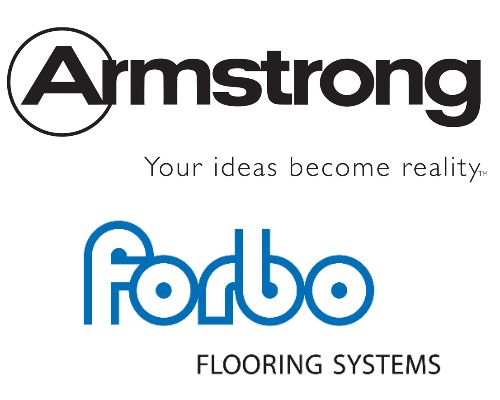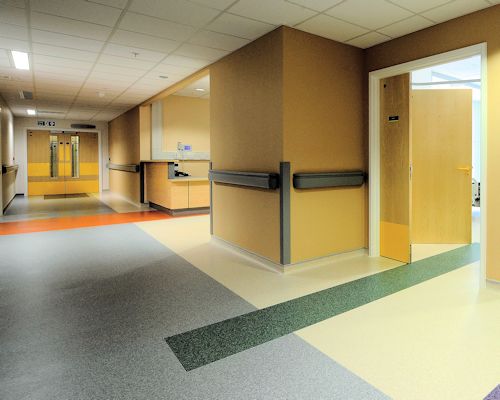 Audio for slide 2 (mp3)
Audio for slide 2 (mp3)
Resilient floor coverings include all the products that have the characteristic of resilience, or 'bounce back'. This distinguishes them from 'non-resilient' flooring products like timber, stone, slate and ceramic tile.
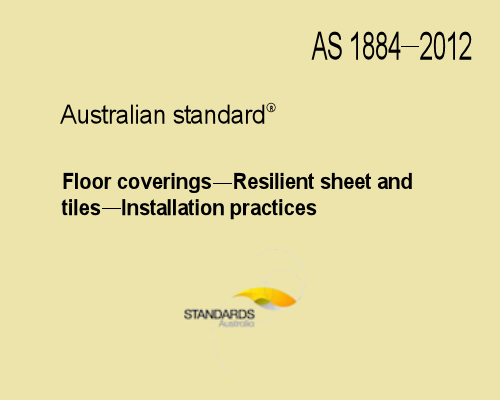 Audio for slide 3 (mp3)
Audio for slide 3 (mp3)
The Australian Standard that covers the installation of resilient products - AS 1884-2012 - defines 'resilience' as the ability of a floor covering to return to its original shape and thickness after being subjected to heavy foot traffic, dropped objects or static loads. In this unit, we'll discuss the installation techniques that apply to commercial vinyl flooring, which is the most common resilient sheet material used in industrial and commercial applications.
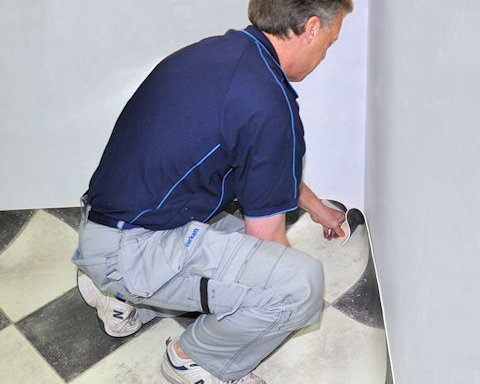 Audio for slide 4 (mp3)
Audio for slide 4 (mp3)
We won't cover lay flat vinyl in this unit, or the general preparations you should make before undertaking an installation. These topics are covered in detail in the unit: Lay flat vinyl, along with the basic principles of cutting sheet products. If you haven't already completed the Lay flat vinyl unit, you should read through it first before tackling the more advanced techniques covered in this unit. We'll also leave two other types of resilient sheet products to other learning units: ESD floors and Linoleum. These specialist units follow on from the installation techniques described in this unit and provide details on the differences that apply to the way they are laid.
 Audio for slide 6 (mp3)
Audio for slide 6 (mp3)
We have also used a variety of photos provided by Tarkett Australia. You can see these photos in the original document by clicking on the following link. Meet Tarkett in daily life
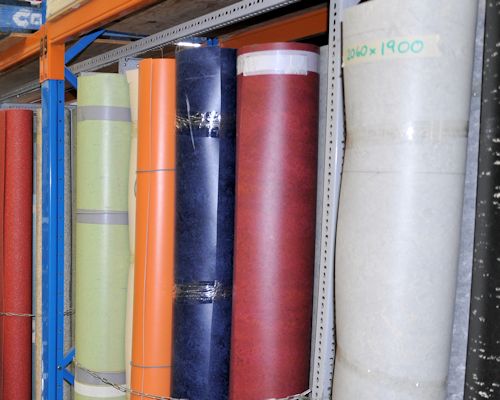 Audio for slide 9 (mp3)
Audio for slide 9 (mp3)
In this section, we'll cover some basic principles relating to commercial vinyl. We'll look at the structure of the product, the range of adhesives used, and basic cutting and fitting techniques.
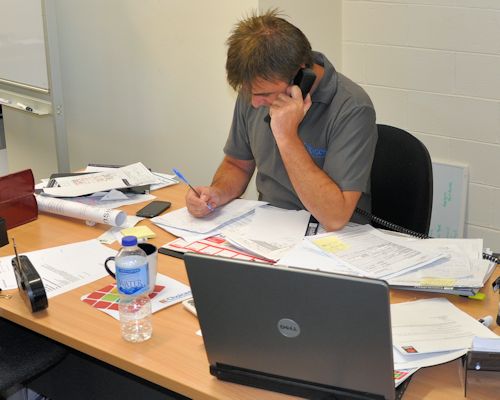 Audio for slide 10 (mp3)
Audio for slide 10 (mp3)
We'll also talk briefly about the planning that goes into getting ready for an installation, and the preparations you should make before you show up to the jobsite. Some of these topics are covered in more detail in other units from this resource. In these cases there are references to the relevant lessons from those units.
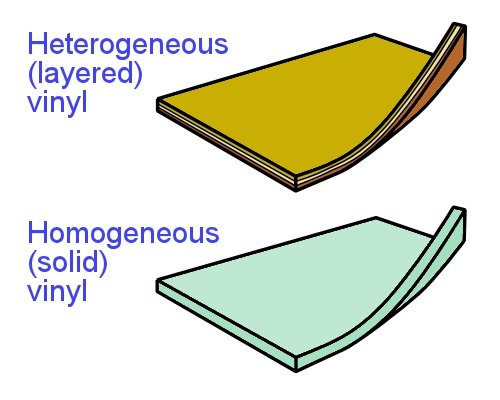 Audio for slide 12 (mp3)
Audio for slide 12 (mp3)
You'll recall that in the unit Lay flat vinyl, we talked about the two main structures used in the manufacture of vinyl flooring: heterogeneous (or layered) vinyl homogeneous (or solid) vinyl. The term 'commercial vinyl' is generally used to refer to homogeneous products that are laid in industrial or commercial applications, such as schools, hospitals, offices and factories.
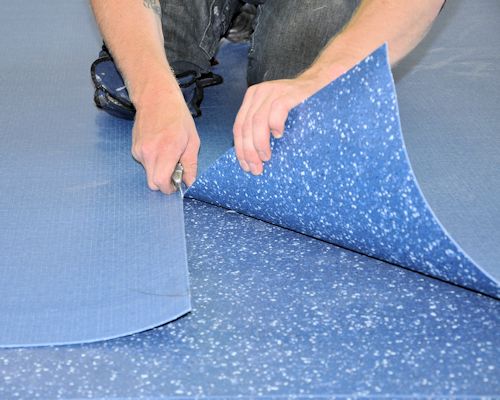 Audio for slide 13 (mp3)
Audio for slide 13 (mp3)
The easiest way to tell whether you've got a solid or layered sheet is to look at the back. Solid sheets are the same colour on both sides, whereas layered sheets have a different colour on the back because it's a different layer.
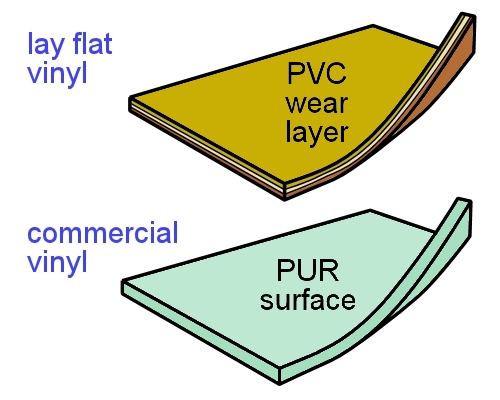 Audio for slide 14 (mp3)
Audio for slide 14 (mp3)
Another common difference between lay flat and commercial vinyl sheets is the make-up of the wear layer on top. Lay flat vinyl generally has a PVC (polyvinyl chloride) wear layer. However, most commercial vinyl products have a PUR (polyurethane) surface treatment, which is tougher and more scuff resistant. The composition of commercial vinyl is a uniform layer of PVC and various additives, such as binders, plasticisers, stabilisers, fillers and pigments.
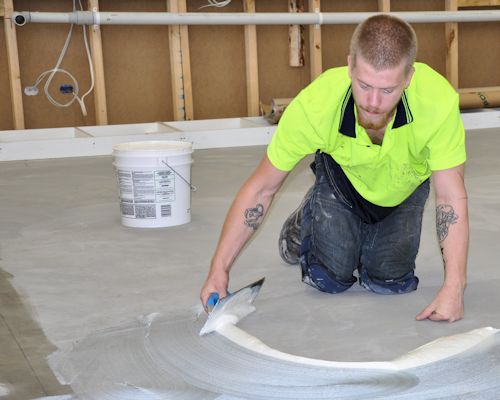 Audio for slide 16 (mp3)
Audio for slide 16 (mp3)
There is no single adhesive that's suitable for all types of resilient floor coverings. The best adhesive for any particular job will depend on a range of factors, including what type of material is being laid, what the substrate is made from and how much wear and tear the floor will be subjected to.
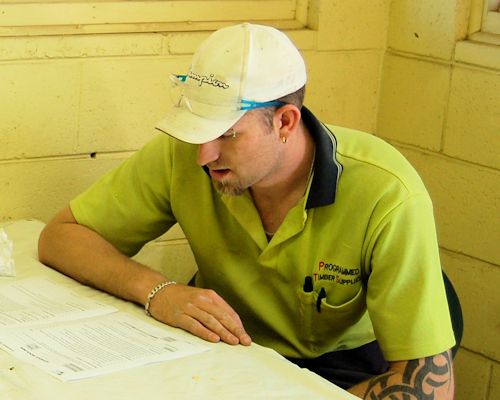 Audio for slide 17 (mp3)
Audio for slide 17 (mp3)
The selection of the most appropriate adhesive is generally made by the floor covering manufacturer and specified in the installation instructions. However, there are times when the client may have unusual site conditions or requirements, and an alternative adhesive needs to be used. In these cases, you should always check with the flooring manufacturer before going ahead - otherwise you may find that you've voided the warranty conditions. Below are the main categories of adhesives used with sheet vinyl installations. Note that with the continuing development of new chemical compounds and combinations of compounds, some products may fall into more than one category.
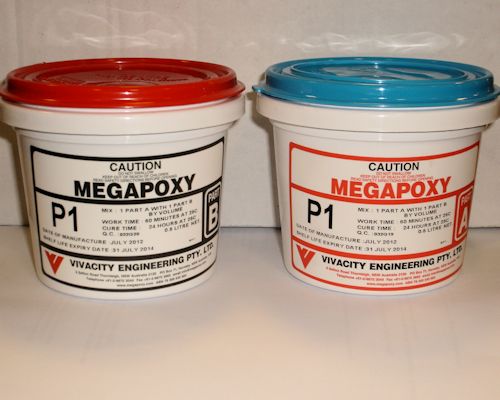 Audio for slide 18 (mp3)
Audio for slide 18 (mp3)
Epoxy Epoxy resins are two part reactive adhesives. That is, when the separate components are mixed together they set off a chemical reaction. They are classified as hard set adhesives because they crystallise to form a non-flexible bond.
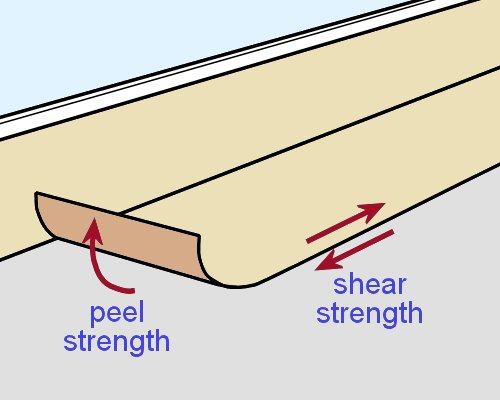 Audio for slide 19 (mp3)
Audio for slide 19 (mp3)
This gives them a high peel strength, meaning that the floor covering does not peel away easily from the substrate. But their shear strength is not as good, which means that they are less resistant to forces that tend to slide one layer against another. This can be a problem in areas where there might be movement in the subfloor, such as on steel floors around gantry cranes.
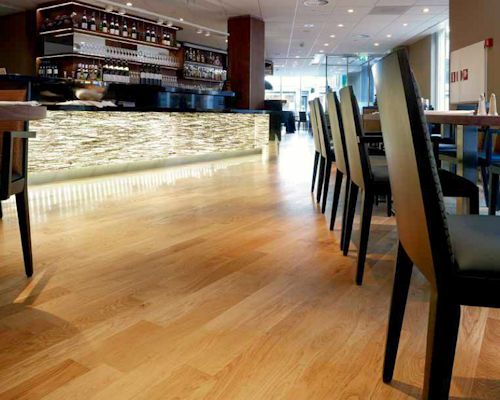 Audio for slide 20 (mp3)
Audio for slide 20 (mp3)
However, they have excellent water and chemical resistance, and can withstand high temperatures. These adhesives are used in wet areas, commercial kitchens, bars and areas subject to high levels of traffic.
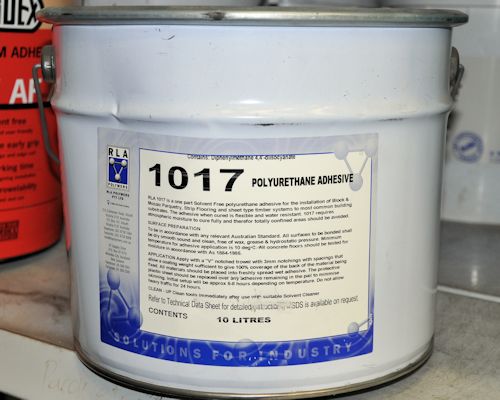 Audio for slide 21 (mp3)
Audio for slide 21 (mp3)
Polyurethane Most polyurethanes are also two-part adhesives that cure due to a chemical reaction between the components, although there are some one-part products. They are classified as semi-soft set, because they remain reasonably flexible and are able to withstand subfloor movements.
 Audio for slide 22 (mp3)
Audio for slide 22 (mp3)
Polyurethanes have excellent sheer and peel strength. They come in a wide range of brand names and are a popular choice for most resilient floor installations. Like the epoxy resins, they are widely used in commercial applications and wet areas.
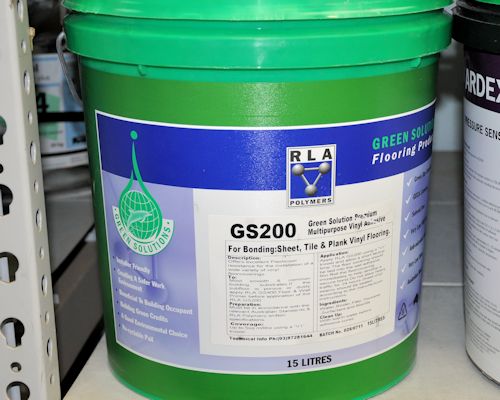 Audio for slide 23 (mp3)
Audio for slide 23 (mp3)
Acrylic There are many acrylic adhesives on the market. Most are solvent based or water based, which means that the curing action occurs when the solvent or water evaporates after the adhesive is applied. They can be one or two part adhesives and are classified as soft set and semi-soft set.
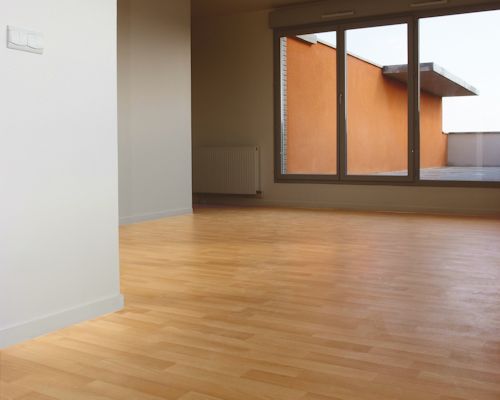 Audio for slide 24 (mp3)
Audio for slide 24 (mp3)
Although their bond strength is excellent, they are generally water soluble, which makes them unsuitable for use in wet areas. Acrylics generally have a longer open time than other adhesives and are non-toxic and non-flammable. They are also highly resistant to plasticiser migration (see the next lesson for details on this problem).
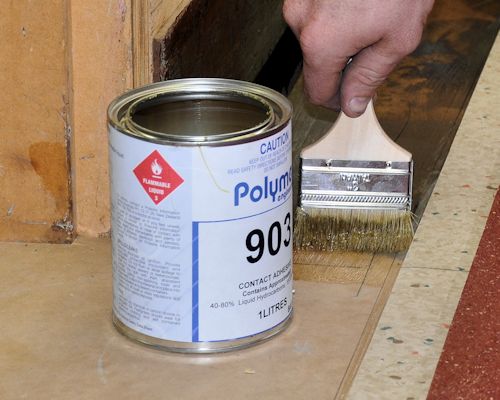 Audio for slide 25 (mp3)
Audio for slide 25 (mp3)
Contact Contact adhesives have a solvent, neoprene or water base and are classed as soft set. The adhesive is applied to both surfaces and allowed to dry before the two surfaces are brought together.
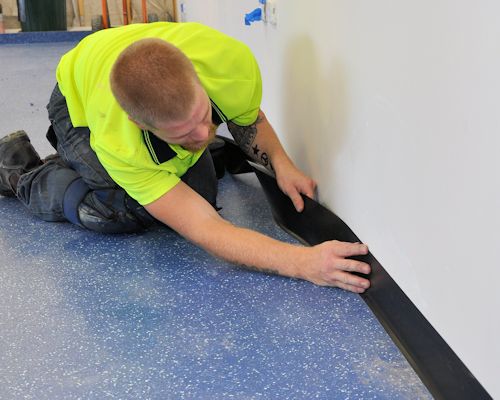 Audio for slide 26 (mp3)
Audio for slide 26 (mp3)
When the surfaces contact each other the bond is instant. This makes them suitable for use on vertical surfaces, such as vinyl skirtings and covings. Note that the adhesive is not waterproof, so the exposed edges must be sealed to stop water penetration.
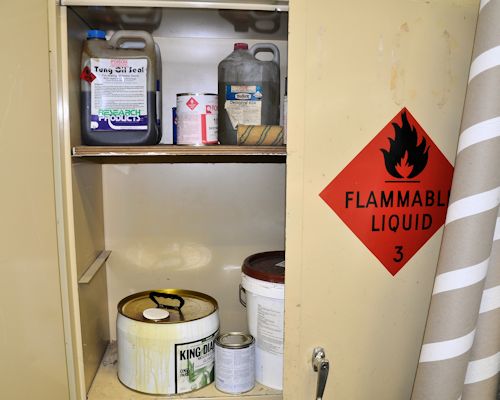 Audio for slide 27 (mp3)
Audio for slide 27 (mp3)
Looking to the future In recent years there has been an enormous amount of research into new formulations for adhesives. The challenge has been to find products that are less damaging to the environment and the health of installers who use them. The main problem for scientists has been that many of these more 'environmentally friendly' water based products are less effective than the adhesives they are designed to replace.
 Audio for slide 28 (mp3)
Audio for slide 28 (mp3)
However, new products are being developed, trialled and brought onto the market all the time. One example is 'Envirostix', a poly-acrylic adhesive system manufactured by Base King. Follow the link below for more information about this product and the issues that they are aiming to overcome. Envirostix
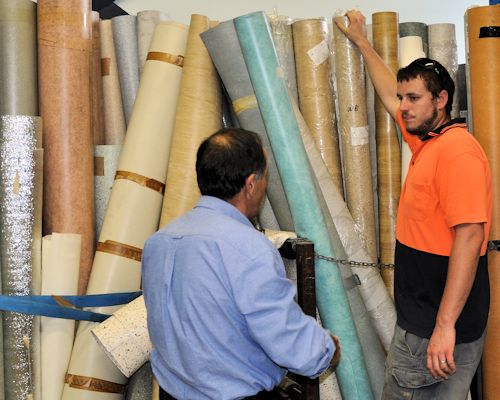 Audio for slide 30 (mp3)
Audio for slide 30 (mp3)
A smooth and efficient installation doesn't happen by chance. It's always the product of careful planning and preparation. For many floor layers, a lot of the arrangements are made in advance by the company that's supplying the flooring products and handling the installation contract. But even when you're working as a subcontractor, you still need to know what the arrangements are and confirm whether everything will be ready for you when you show up on-site to start the installation.
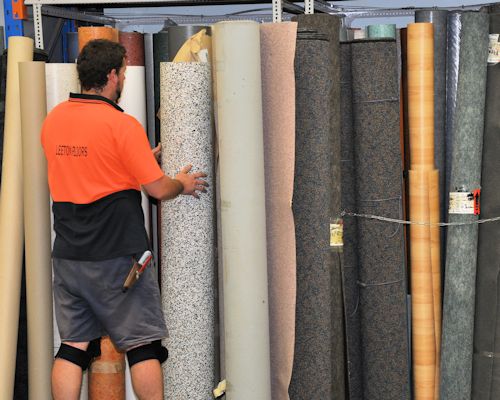 Audio for slide 31 (mp3)
Audio for slide 31 (mp3)
Set out below is a summary of the main factors that need to be considered before you physically begin the installation. Also shown are references to the other units that have more information about these topics.
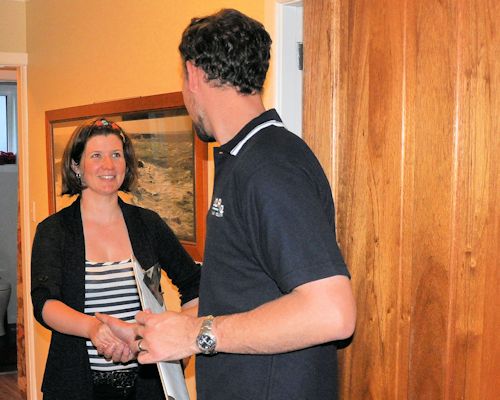 Audio for slide 32 (mp3)
Audio for slide 32 (mp3)
Site access and working conditions One of the most important issues that need to be dealt with is access to the worksite and the condition it should be in when you arrive. This includes organising a day that suits everyone, as well as making sure that no other trade work will be going on that could hold up your progress. It also includes making arrangements in advance about who is responsible for moving existing furniture, appliances and old floor coverings. For more details on these issues, follow the links below. Dealing with the client (Lay flat vinyl) Issues to consider' (Planning and costing)
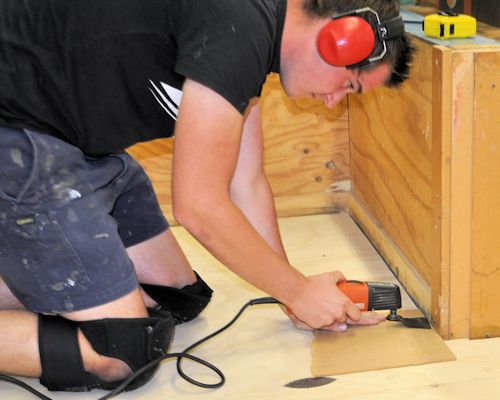 Audio for slide 33 (mp3)
Audio for slide 33 (mp3)
Health and safety Professional floor layers take safety very seriously - because they know that a happy, healthy life is far more valuable than a bit of time saved by taking shortcuts or not following safe procedures. We've dealt with various aspects of health and safety throughout this series of learner guides. Below is a summary of the main topics relevant to resilient floor laying that are covered in other guides. You should go back to these lessons if you need to refresh your memory on the details.
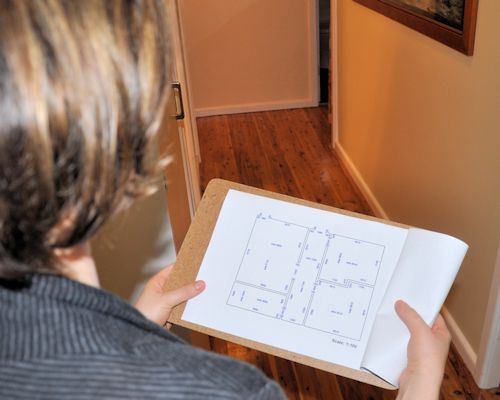 Audio for slide 34 (mp3)
Audio for slide 34 (mp3)
Documentation The main document that sets out the specifications of a flooring project is the floor covering plan. Some contracting companies give their installers a job sheet, which contains most of the information contained in the floor covering plan, but also provides details relating to specific products used and arrangements that have been made with the client. For more information about these documents, follow the links below. Floor covering plans (Planning and costing) Documentation (Lay flat vinyl)
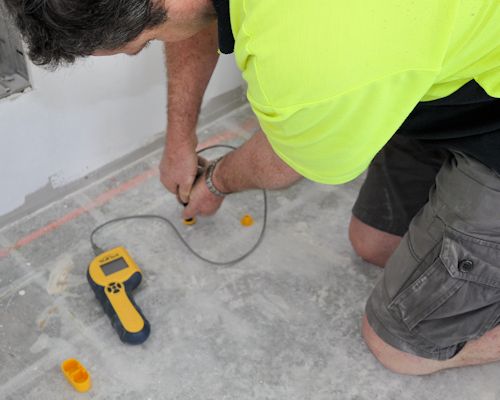 Audio for slide 35 (mp3)
Audio for slide 35 (mp3)
Subfloor assessment When something goes wrong with a finished floor, more often than not the problem can be traced back to the condition of the subfloor. Sometimes a problem only becomes obvious months or even years after the installation was completed. But as a professional installer, you'll still be liable for the cost of repairs if it can be proved that you didn't properly assess the subfloor and deal with any issues that you were responsible for at the time. Because this is such a crucial topic, we've revisited it in several units. However, the most comprehensive coverage is in the units below. Inspecting and testing subfloors Lay flat vinyl.
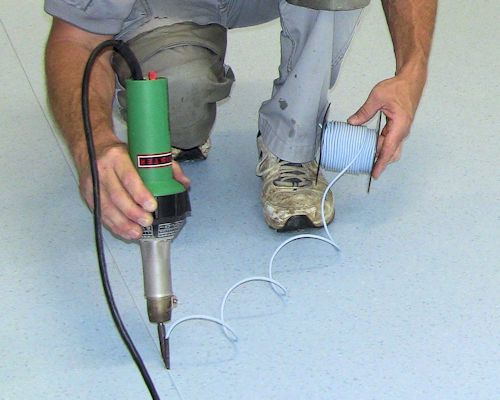 Audio for slide 36 (mp3)
Audio for slide 36 (mp3)
Tools and equipment The tools you'll need for any particular project will depend on the specifications of the job and the site conditions you're faced with. We talked about the basic range of hand tools required in the lesson shown below. So in this unit, we'll move on to the specific tools needed for heat welding and other specialised tasks. Tools and equipment (Lay flat vinyl)
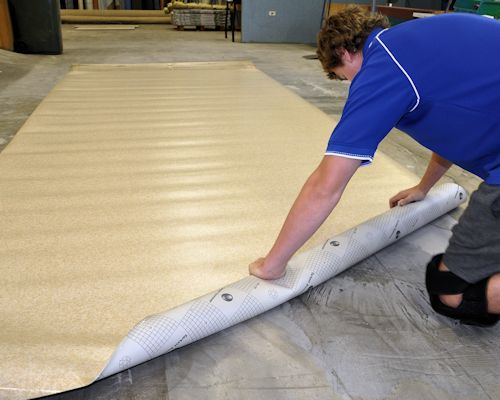 Audio for slide 38 (mp3)
Audio for slide 38 (mp3)
Sheet products are tightly rolled in the factory where they're made. This puts the material under tension, which is only released when the material is unrolled again. As the material returns to normal, it will shrink slightly in length. The best way to avoid problems with shrinkage is to re-roll a cut length back on itself and wait for about 15 minutes. Then you can unroll it again and start fitting it in position.
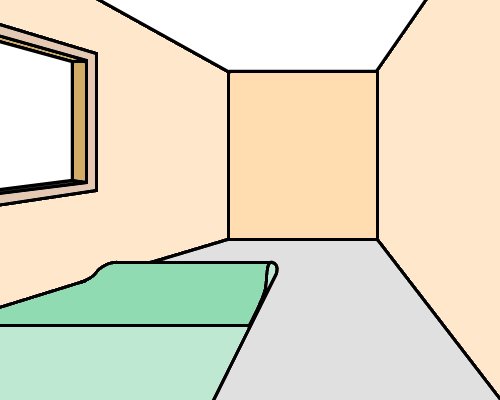 Audio for slide 39 (mp3)
Audio for slide 39 (mp3)
If you're fitting a long length, such as in a corridor, you should take the extra precaution of only scribing and sticking down the sheet up to about the last 2 metres. Then scribe the second end, spread the remaining adhesive and stick that end down. Note that the whole sheet must be stuck down before the adhesive sets. If the first part starts to set before you lay down the last section, any overspread in adhesive might result in bubbles where the two parts meet.
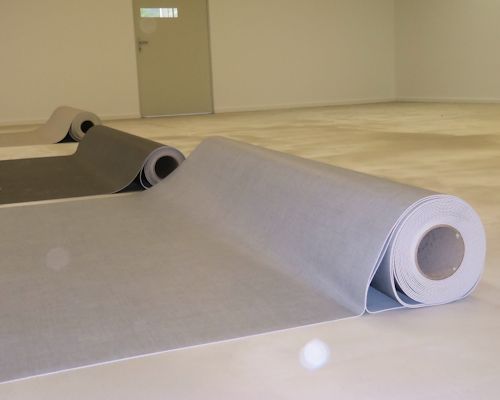 Audio for slide 40 (mp3)
Audio for slide 40 (mp3)
Conditioning Before you begin an installation, you need to let the floor covering condition to the surrounding temperature and humidity in the room. This process is also called acclimatisation. AS 1884 says that floor coverings should be conditioned for at least 24 hours, or until the product has achieved an 'ambient room temperature' range of between 15° and 28° C. For more information on the conditioning process, including the procedures you should follow in buildings with air conditioners or heated floors, go to the lesson shown below. Conditioning (Preparing floor coverings)
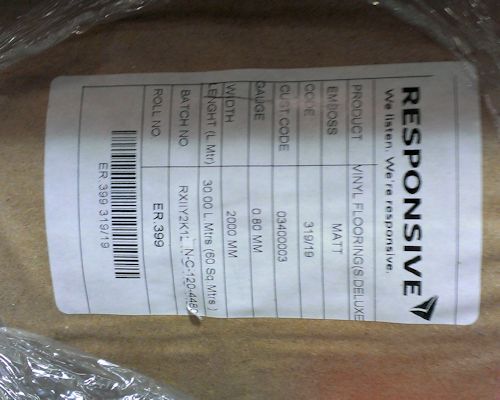 Audio for slide 41 (mp3)
Audio for slide 41 (mp3)
Batch lots Floor coverings are manufactured in batch lots, also called dye lots. Each roll of material has a batch number on the packaging to indicate which batch of colour dyes was used in that particular manufacturing run. It will also have a roll number. Where possible, you should try to use flooring with the same batch number and sequential roll numbers when they are being placed side by side. This will help to provide the best match of colours and avoid any inconsistency in shade or intensity.
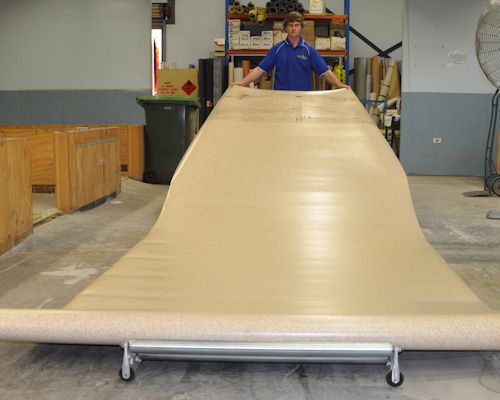 Audio for slide 42 (mp3)
Audio for slide 42 (mp3)
Handling long lengths An easy way to lay out long lengths of sheet material on the floor is to use a linoleum dolly. The dolly not only allows you to roll out the material with the face side up, it also reduces the risk of injury.
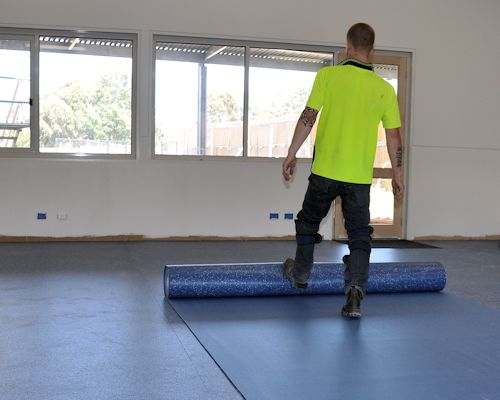 Audio for slide 43 (mp3)
Audio for slide 43 (mp3)
There will be times, however, when you won't have access to a dolly on-site and you'll have to make do with your own manual handling skills. In these cases, you should roll out the material on the floor with the face side down, and then turn it over. The learning activity below will give you some hints on how to turn over a long sheet without damaging the material or straining yourself.
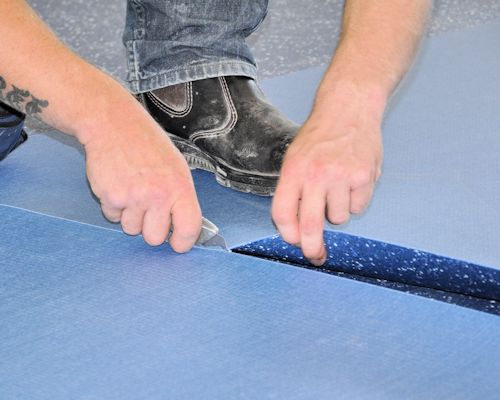 Audio for slide 45 (mp3)
Audio for slide 45 (mp3)
The basic techniques used to cut and scribe resilient sheets are similar for all sheet products, including lay flat vinyl, commercial vinyl and linoleum. We covered these principles in Lay flat vinyl, under the lessons shown below. So in this lesson we'll look at the main differences that apply to commercial vinyl.
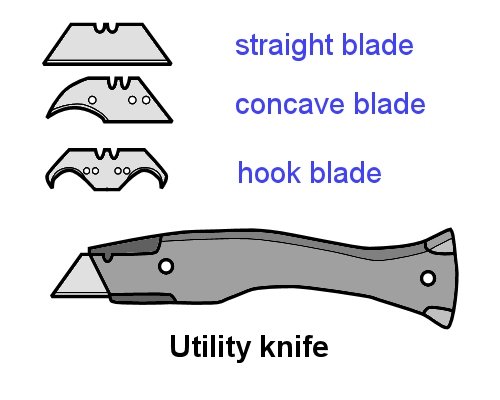 Audio for slide 46 (mp3)
Audio for slide 46 (mp3)
Seams and joins Commercial vinyl is thicker and tougher than lay flat vinyl, so you need to cut it in two passes of your knife - first with a straight or concave blade and then with a hook blade.
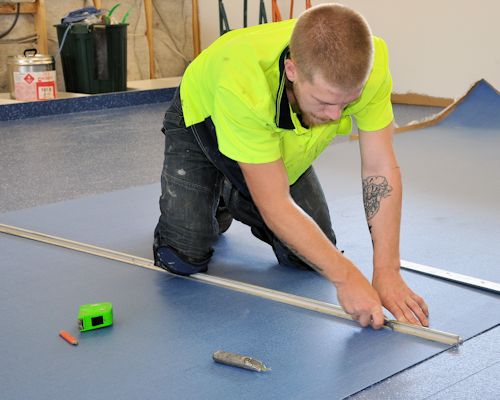 Audio for slide 47 (mp3)
Audio for slide 47 (mp3)
With the first cut, keep the blade vertical so that it runs cleanly and safely along the straightedge. Maintain an even pressure and cut to a depth of about halfway to two thirds. With some materials you may need more than one pass to achieve this depth. Then complete the cut with a hook blade. If you want to make a bevel cut, such as when you're fitting to a wall, you can tilt the blade slightly.
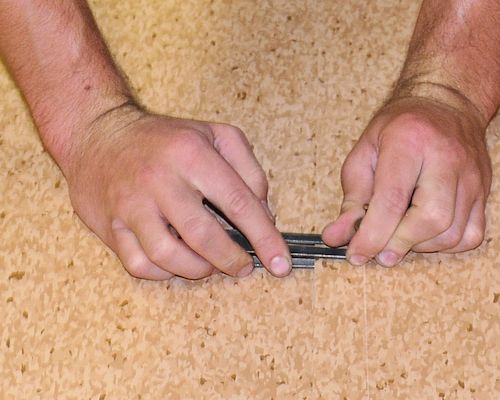 Audio for slide 48 (mp3)
Audio for slide 48 (mp3)
Using a recess scriber When you get to the second sheet, you can mark it with a recess scriber instead of using the straightedge, if you prefer. A recess scriber is also called an under and over scriber, or simply 'unders and overs'.
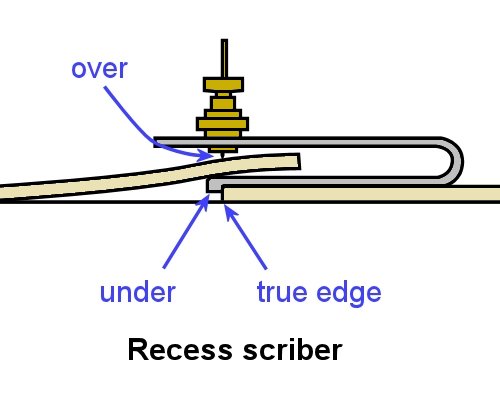 Audio for slide 49 (mp3)
Audio for slide 49 (mp3)
The scribing procedure is as follows: Set the 'over' scribe pin to the point where the 'under' guide will run along the true edge. You can test the setting at one end of the sheet nearest the wall and make adjustments if required. Place the second sheet over the first sheet. Scribe the top of the second sheet, keeping the 'under' firmly against the true edge of the first sheet. Cut the scribed sheet using a straight blade and then a hook blade. If the scribe mark is hard to see in the vinyl surface, you can rub it with chalk to highlight the line.
 Audio for slide 52 (mp3)
Audio for slide 52 (mp3)
In this section, we'll talk about the techniques used to stick down commercial vinyl and finish the job with heat welded seams. When these tasks are done properly, the resilient floor becomes a very durable surface that will last for many years. But there are some potential issues you need to look out for, because they can mean the difference between a high quality job and a call-back to rectify a problem. We'll discuss ways of avoiding these issues.
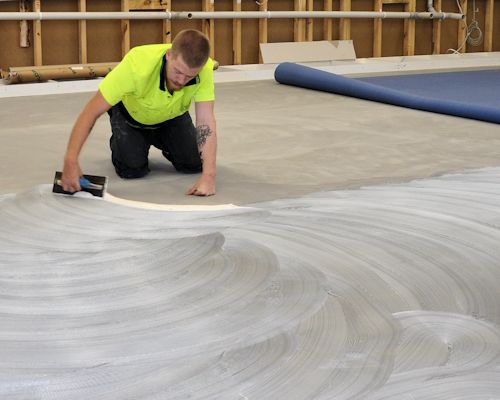 Audio for slide 54 (mp3)
Audio for slide 54 (mp3)
We covered the process of applying an adhesive in the following lesson. Full spread installation (Lay flat vinyl) Below is a summary of the procedure. If you need to revise any of the details, you should go back to that lesson and read the material again.
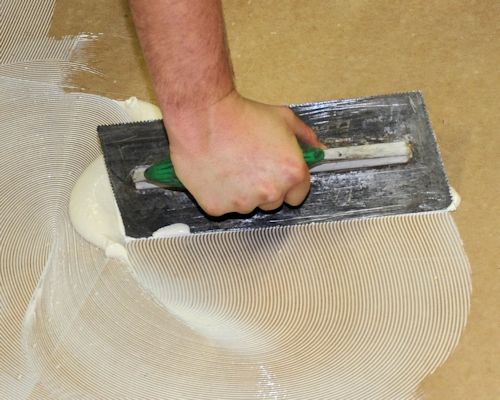 Audio for slide 55 (mp3)
Audio for slide 55 (mp3)
Notched trowels Most adhesives are designed to be spread with a notched trowel. The purpose of the notches is to control the amount of adhesive that's spread on the substrate. Manufacturers sometimes specify different trowel notchings for particular flooring and adhesive products. It's important to follow these specifications, because if you don't, you'll end up applying either too much or too little adhesive.
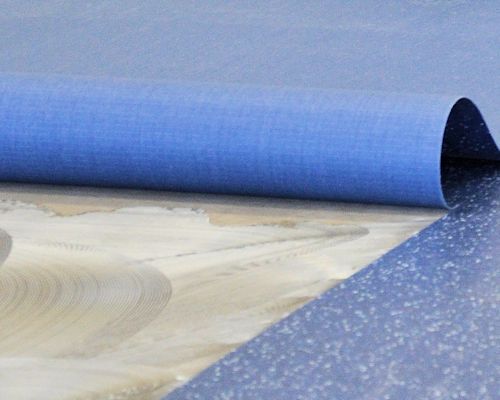 Audio for slide 56 (mp3)
Audio for slide 56 (mp3)
Open time Once an adhesive has been spread, you need to wait until the open time has elapsed before placing the floor covering in position. This is also called the tack up time, because the ridges in the adhesive start to 'skin over'. If you place flooring onto the adhesive too soon, it traps the gasses being given off and can cause bubbles under the surface.
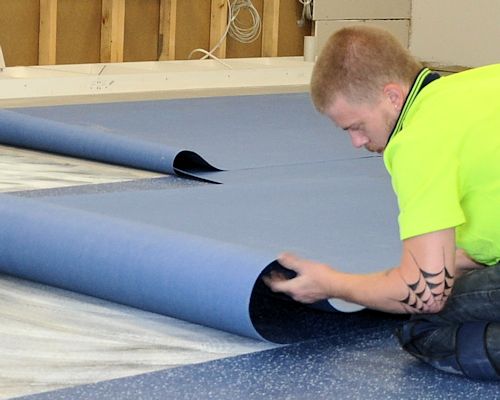 Audio for slide 57 (mp3)
Audio for slide 57 (mp3)
Working time When the adhesive is ready for the flooring to be placed on top, the working time begins. This is the time you have available to lay the material and complete all cutting and fitting. If you place flooring onto the adhesive after the working time has passed, the flooring won't bond properly.
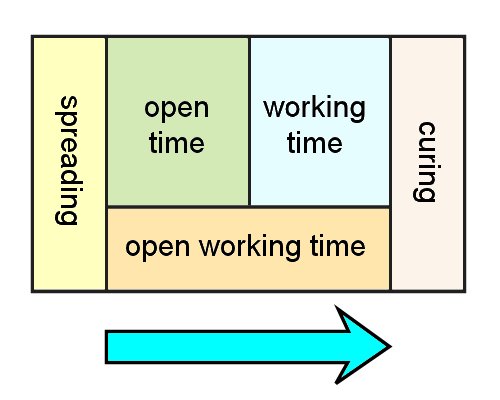 Audio for slide 58 (mp3)
Audio for slide 58 (mp3)
Variations in open and working time The open time and working time of an adhesive will vary depending on the temperature, humidity and porosity of the surface. High temperatures, low humidity and porous surfaces will all reduce the times. For very porous surfaces, such as wood-based underlays, manufacturers generally specify that a primer be applied first with a brush. This helps to avoid the problem of late placement, where the adhesive has already set and will no longer bond to the flooring covering.
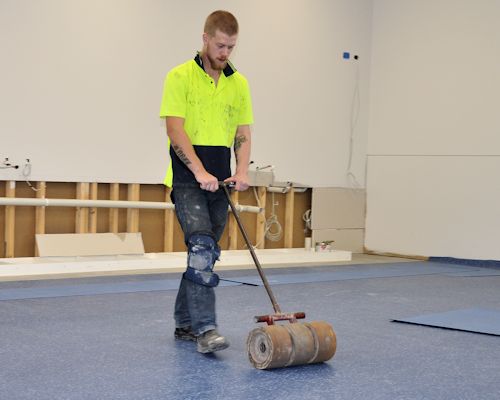 Audio for slide 59 (mp3)
Audio for slide 59 (mp3)
Rollers Once the floor covering has been placed in position and fitted, it needs to be pushed firmly into the adhesive. You should do this with a heavy floor roller, running lengthwise and then across the floor.
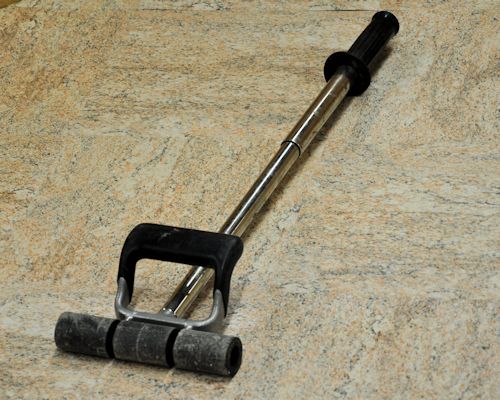 Audio for slide 60 (mp3)
Audio for slide 60 (mp3)
In areas that can't be reached with a floor roller, use a hand roller. Be sure to roll the edges and seams properly, because these are the areas where adhesive failures tend to start.
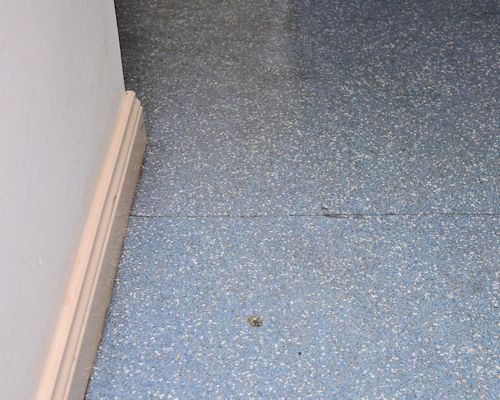 Audio for slide 62 (mp3)
Audio for slide 62 (mp3)
It's worth remembering that most resilient floors never get a chance to actually wear out. In practice, they often need replacement before they reach that stage because the adhesive has either failed or caused discolouration in the floor surface. Below are some of the problems relating to adhesives and the technical terms used to describe the issues.
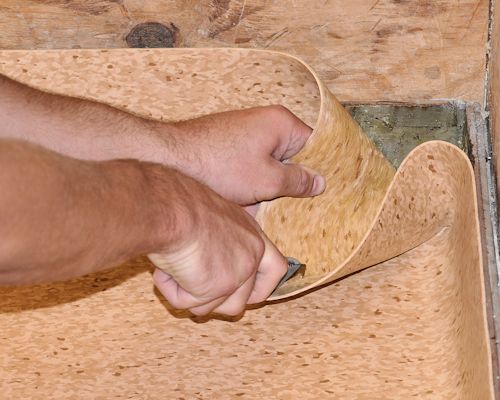 Audio for slide 63 (mp3)
Audio for slide 63 (mp3)
Plasticiser migration Plasticisers are used in vinyl flooring products to soften the material and improve its flexibility. They're also used in adhesives to improve tack, or stickiness. Two common plasticisers are mineral oil and hydrocarbon oil.
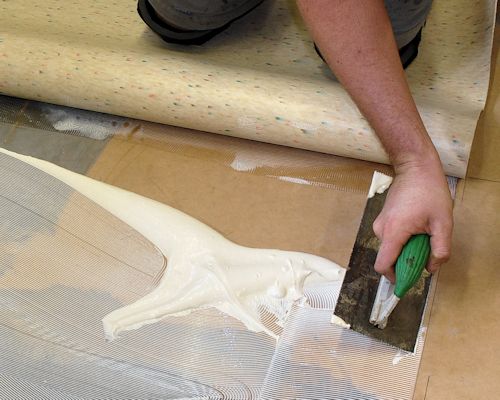 Audio for slide 64 (mp3)
Audio for slide 64 (mp3)
When plasticisers leech out - or 'migrate' - from the flooring into the adhesive, they can send the adhesive soft and break down its holding power. This tends to happen when multi-purpose adhesives are used with vinyl-backed sheet floors. The best way to avoid plasticiser migration is to only use adhesives that have been specifically recommended by the flooring manufacturer. This ensures that the two products are compatible with each other.
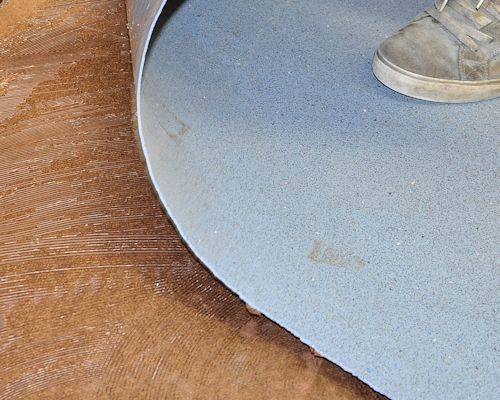 Audio for slide 65 (mp3)
Audio for slide 65 (mp3)
Adhesive failure When an adhesive doesn't bond properly to the substrate, the problem is often due to dampness in the subfloor, a curing compound on the surface, or weak material or dust on the surface.
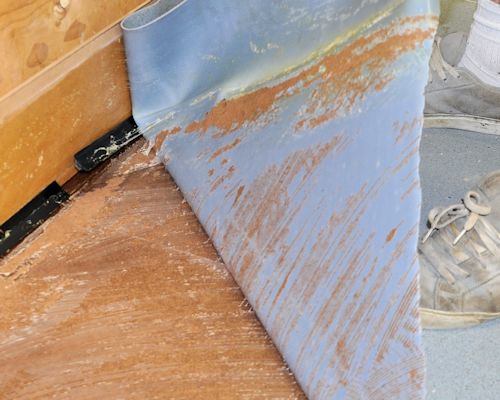 Audio for slide 66 (mp3)
Audio for slide 66 (mp3)
If the adhesive doesn't bond properly to the underside of the floor covering, the failure is more likely to be caused by late placement. That is, the floor covering has been placed on top of the adhesive after it has set. The problem can also be due to using a worn or incorrectly-sized notched trowel, resulting in poor transfer of adhesive to the floor covering. In other cases, it could simply be because the wrong adhesive has been used.
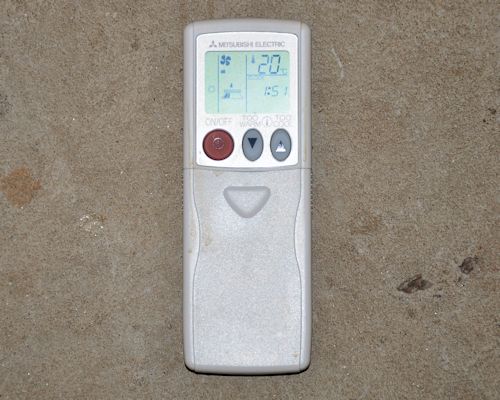 Audio for slide 67 (mp3)
Audio for slide 67 (mp3)
Temperature extremes Adhesives should only be used when the room and subfloor temperatures are within the range specified by the manufacturer. High temperatures can cause the solvent to evaporate too quickly in solvent-based adhesives, resulting in thickening and early setting. Low temperatures can result in poor workability and heavy spread. In the case of emulsion-type adhesives, low temperatures can cause the components to break down and separate.
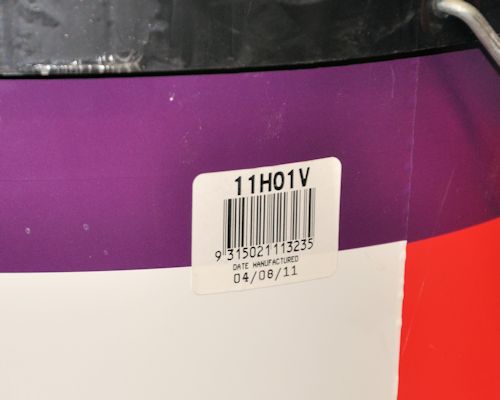 Audio for slide 68 (mp3)
Audio for slide 68 (mp3)
Shelf life and pot life Some adhesives have a 'use-by' date stamped on the container or drum, indicating how long the product can be kept on the shelf. Once this shelf life has expired, you can no longer guarantee that the product will work exactly as you expect it to, because the components might start to deteriorate. The photo at left shows a sticker with the date of manufacture printed on it. Although this isn't a use-by date, it still lets you see how old the product is. You should always try to rotate the stock on the shelf, using the older stock first.
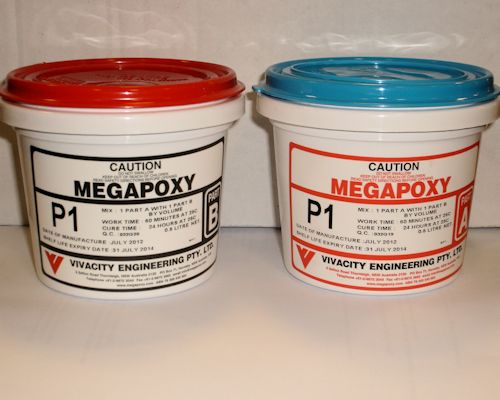 Audio for slide 69 (mp3)
Audio for slide 69 (mp3)
Pot life refers to the length of time you have available to use a two-part adhesive once you've mixed the components together, before it becomes thick and unworkable. It's similar to 'working open time', which we discussed earlier in this section. Don't forget that the pot life shown on the container will refer to a particular temperature range, such as 20-23° C. If the temperature is hotter, the pot life will be reduced. If it's colder, the pot life will be increased.
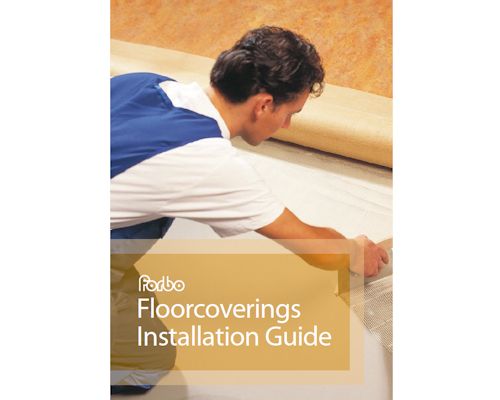 Audio for slide 70 (mp3)
Audio for slide 70 (mp3)
Diagnosing faults The link below will take you to a table showing some of the typical problems you're likely to see in a floor when the adhesive fails. It is adapted from the 'Adhesives fault diagnosis' table produced by Forbo Flooring Systems in their publication: Forbo Floorcoverings Installation Guide. Note that the descriptions of problems and their causes are only generalisations. In practice, there might be other reasons why a particular floor has failed. Adhesive problems and causes
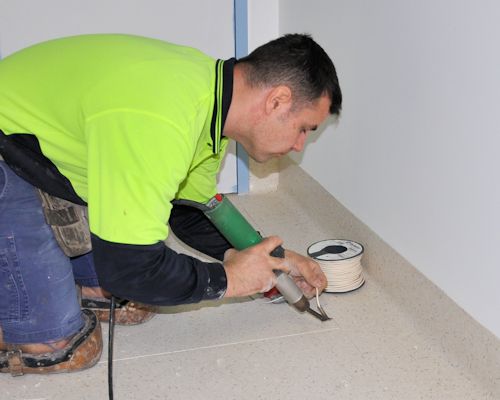 Audio for slide 72 (mp3)
Audio for slide 72 (mp3)
Commercial vinyl seams are always heat welded. This stops dirt, moisture and other substances from getting into the joins. The job specifications will generally set out the specific requirements for the welds, particularly in projects where hygiene is important, such as in hospitals and aged care facilities.
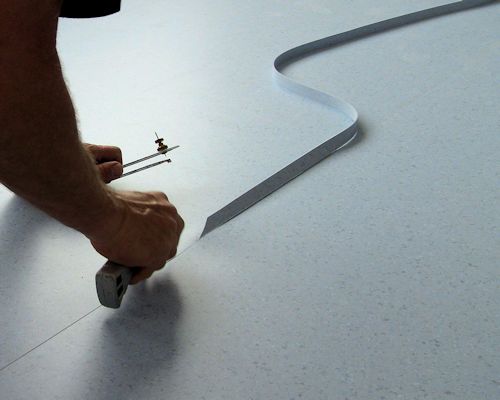 Audio for slide 73 (mp3)
Audio for slide 73 (mp3)
Although the welding cable and flooring material melt and fuse together, the seams still need to be well cut and fitted properly, otherwise the welded join will be very noticeable. Note that some people say 'welding rod' instead of 'welding cable'. Both of these terms mean the same thing.
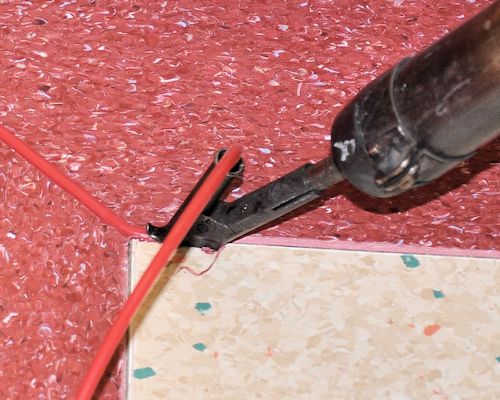 Audio for slide 74 (mp3)
Audio for slide 74 (mp3)
Welding equipment Most installers use hand-held tools to heat weld a seam. However, on large projects installers sometimes use powered machines. Below are the typical tools used in heat welding.
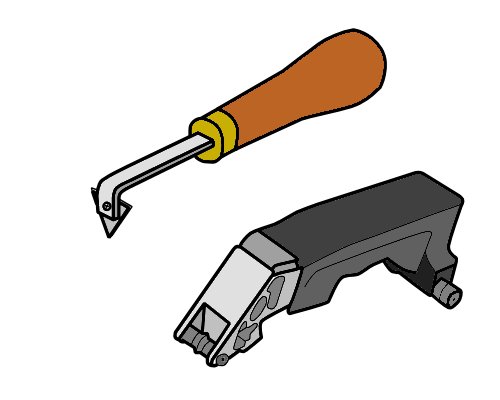 Audio for slide 75 (mp3)
Audio for slide 75 (mp3)
Hand groover or turbo groover - used to groove out the seam in preparation for heat welding with a welding cable. The depth and width of the groove may vary, depending on the type of flooring product being welded.
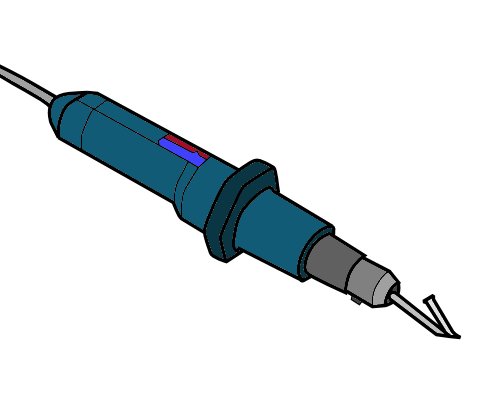 Audio for slide 76 (mp3)
Audio for slide 76 (mp3)
Welding gun - used to heat the flooring material and welding cable so that they melt and fuse together. The gun is fitted with the correct tip to match the welding cable diameter and type of flooring being welded.
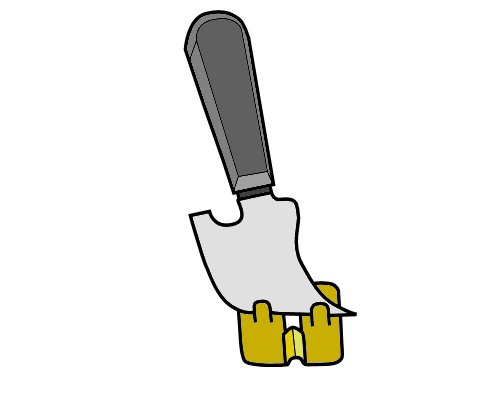 Audio for slide 77 (mp3)
Audio for slide 77 (mp3)
Spatula and slider - used to trim the welded material in the first pass. Once the welded material cools it is trimmed a second time, flush with the floor surface, using the spatula only.
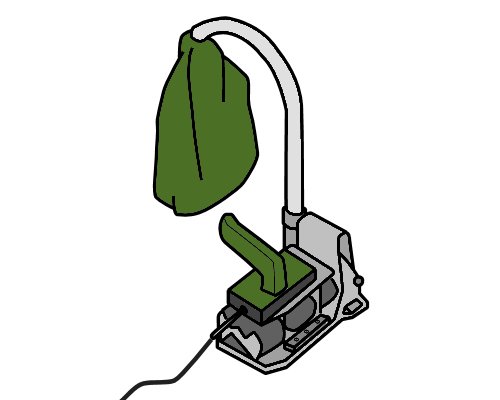 Audio for slide 78 (mp3)
Audio for slide 78 (mp3)
Grooving machine - an alternative to a hand groover. There are various types of electric-powered machines available.
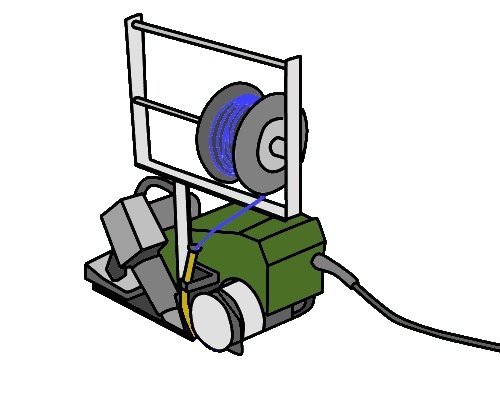 Audio for slide 79 (mp3)
Audio for slide 79 (mp3)
Welding machine - an alternative to a hand-held welding gun. Again, there are various types and sizes available to suit different applications and job sizes.
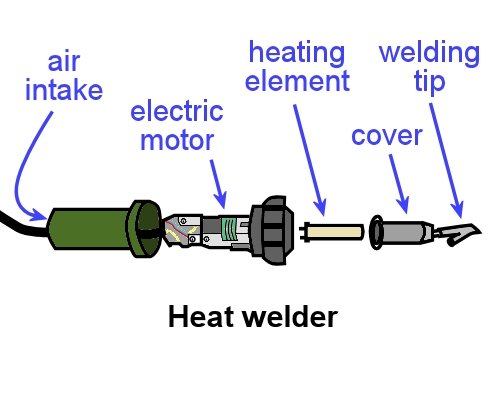 Audio for slide 80 (mp3)
Audio for slide 80 (mp3)
Welding gun maintenance When it's looked after properly, a welding gun should last for many years. The way it works is quite simple - air is sucked in at the back, heated by a heating element, and blown out through the tip. However, if dust is allowed to build up in the air intake gauze, it can be drawn into the electric motor and cause it to overheat.
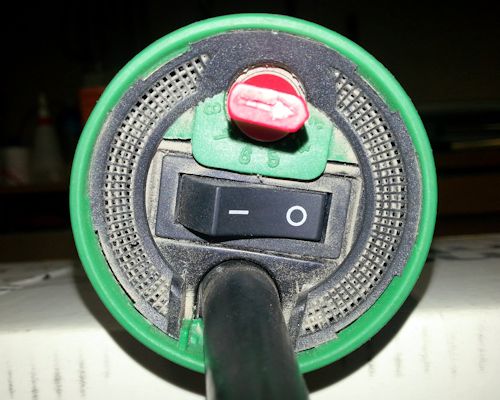 Audio for slide 81 (mp3)
Audio for slide 81 (mp3)
Always keep the intake gauze clean, and check that there is no build-up of lint or dust before you turn it on. The heating element is also very sensitive. You need to let it cool down before you switch off the internal fan so it doesn't burn out.
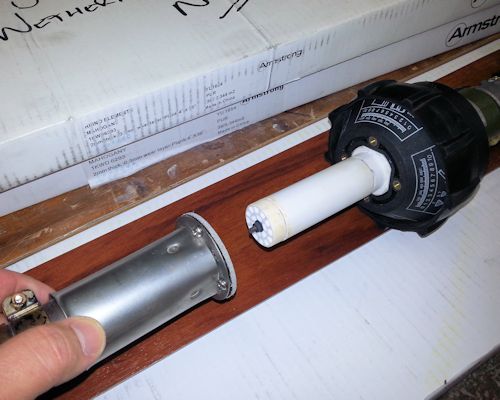 Audio for slide 82 (mp3)
Audio for slide 82 (mp3)
Installers often carry a spare heating element with them just in case they need to replace it while they're on the job. Note that you should never pull apart the electrical side of a welder or tamper with the wiring. Always leave those sorts of repairs to an electrician.
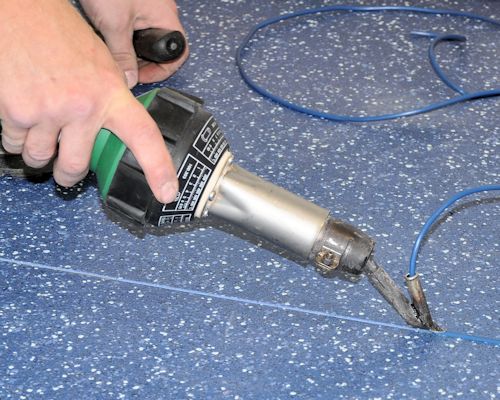 Audio for slide 84 (mp3)
Audio for slide 84 (mp3)
The first step in achieving a good weld is to wait until the adhesive has properly dried. For most types of adhesive, the minimum waiting time is overnight. If you start to weld before the adhesive has dried, the heat from the gun will turn the moisture into water vapour, which will affect the quality of the thermo-fusion (or 'heat' fusion) that takes place.
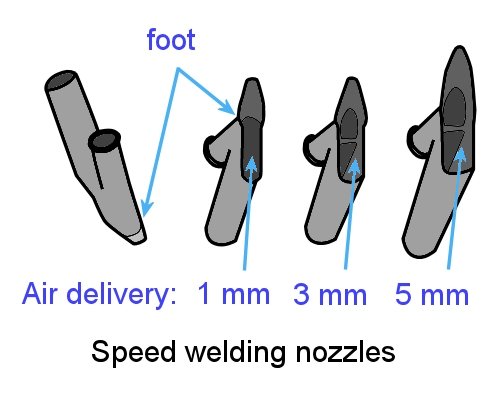 Audio for slide 85 (mp3)
Audio for slide 85 (mp3)
Secondly, you must select the correct tip - or 'nozzle' - for the type of material being welded. The size of the foot at the base of the tip controls the amount of air being blown through. Most solid (or homogeneous) sheets require a 5 mm speed tip. Layered (or heterogeneous) sheets, on the other hand, generally need a 3 mm tip to reduce 'glossing' on either side of the seam.
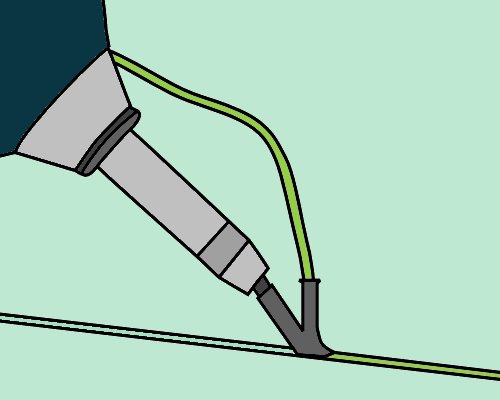 Audio for slide 86 (mp3)
Audio for slide 86 (mp3)
Thirdly, you need the right combination of temperature, speed and pressure. The correct temperature will be specified in the flooring manufacturer's guidelines. The speed and downward pressure will depend on the materials you're welding and the model and temperature of the welding gun. Vinyl seams are generally welded at about 2 metres per minute.
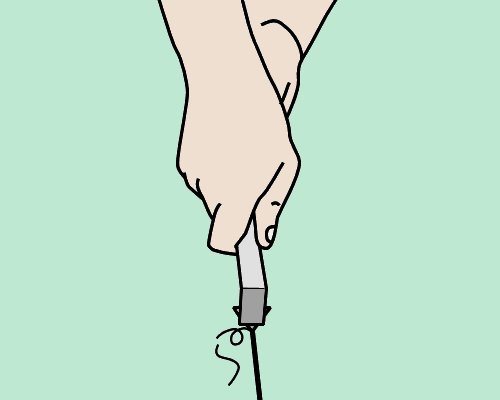 Audio for slide 87 (mp3)
Audio for slide 87 (mp3)
Manual welding procedure The general procedure used to manually groove and heat weld a seam in commercial vinyl is as follows: Groove out the seam to two-thirds of the depth of the material with a hand groover or turbo groover. Make sure that the width of the ribbon that's cut from the edge of each sheet is the same.
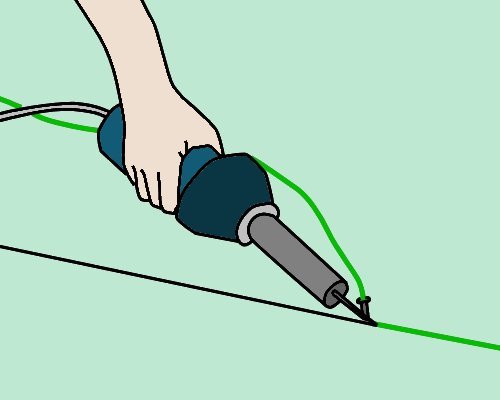 Audio for slide 88 (mp3)
Audio for slide 88 (mp3)
Turn the welding gun on, and let it reach the set operating temperature. Cut the welding cable to length, and thread it through the nozzle. Weld the material, starting at the wall and moving away at a steady speed.
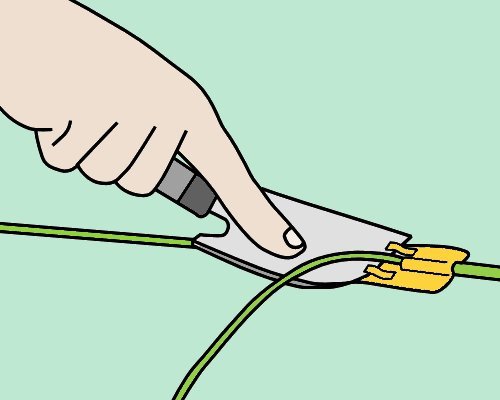 Audio for slide 89 (mp3)
Audio for slide 89 (mp3)
Complete the weld and trim off the excess material down to about half a millimetre using a sharp spatula and slider. Do this while the cable is still warm so that it cuts smoothly without gouging. This first cut will also help the cable to cool more quickly.
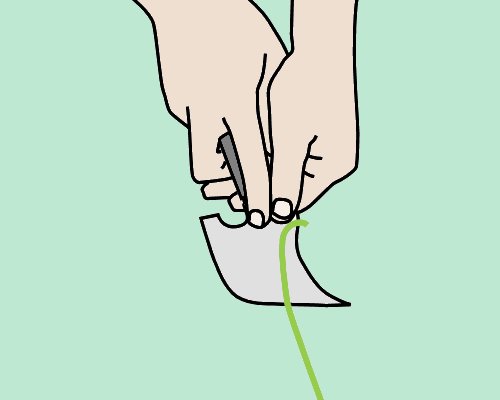 Audio for slide 90 (mp3)
Audio for slide 90 (mp3)
Wait until the material cools, and then trim the cable flush with the floor surface using a spatula angled slightly across the line of the cut. If the trimming action pulls out the weld, you'll need to remove it and do that part again with fresh welding cable.
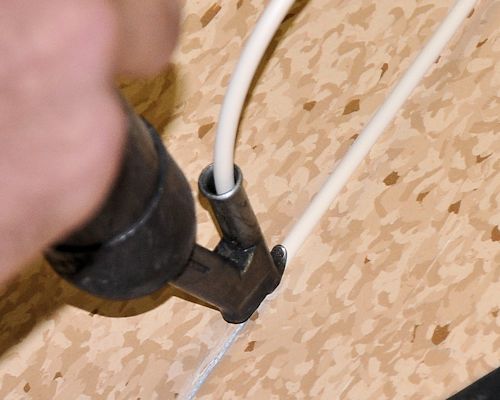 Audio for slide 91 (mp3)
Audio for slide 91 (mp3)
Joining a weld To join a weld where you've left off in the middle of a seam: Trim the loose end with a knife and chamfer down the end of the existing weld with a hand groover where it is to be overlapped. Start the gun at the end of the existing weld and apply pressure as it travels over the un-welded section. Complete the weld and trim as normal.
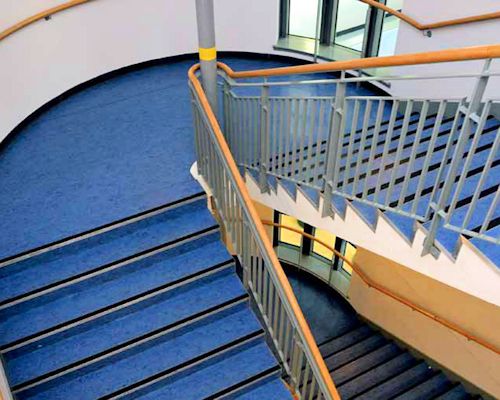 Audio for slide 92 (mp3)
Audio for slide 92 (mp3)
Welding PUR coated floors Most resilient sheet products have a PVC (polyvinyl chloride) coating on top. However, there is an increasing range of PUR (polyurethane) coated products coming onto the market. These provide the benefit of a harder wearing surface for the client, but present a new headache for the installer who has to weld them. PUR surfaces tend to plasticise and decompose at lower temperatures than PVC. If they're welded in the same way as for PVC, the surface can be discoloured or destroyed.
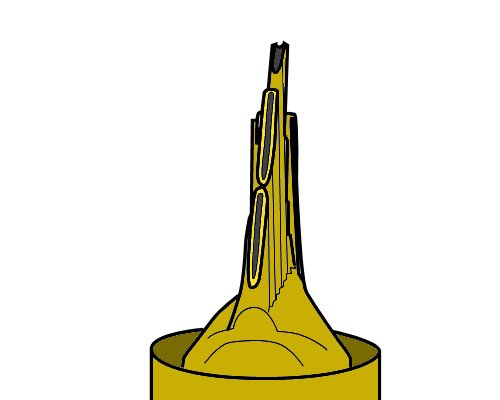 Audio for slide 93 (mp3)
Audio for slide 93 (mp3)
There are special welding tips used for PUR floors, designed to heat the inner areas of the groove to the required temperature without destroying the surface. One example is the 'air knife' nozzle developed by Leister (see the second video clip from the last lesson - 'Welding floor with the Leister Unifloor').
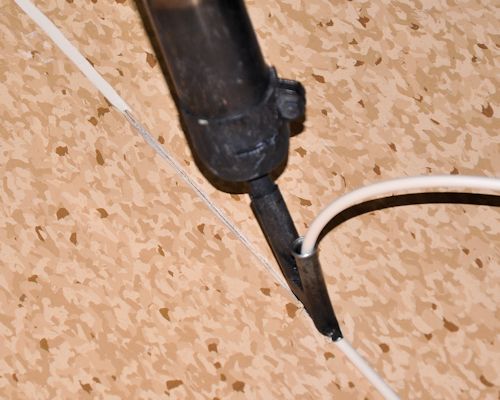 Audio for slide 95 (mp3)
Audio for slide 95 (mp3)
There are lots of reasons why welds fail. Sometimes it is due to problems in the materials or subfloor. Other times it's simply due to a lack of skill or knowledge in the process. However, heat welding is like most other skills, in that the more you practise the better you'll get. Below are some of the common problems that can occur with welds. They are summarised from an article on the Floor Trends website called 'Why did the heat melt fail?' To access the full article, go to the website at the link below, and register your name. Note that registration is free. Why did the heat melt fail?
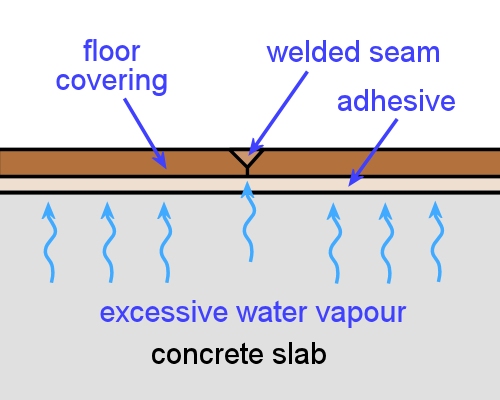 Audio for slide 96 (mp3)
Audio for slide 96 (mp3)
Common problems Substrate and adhesive Excessive moisture in the slab Water vapour in the seam can affect the heat fusion process and reduce its bonding strength. Wet adhesive For most adhesives, you need to wait until the following day before you start to weld the seams.
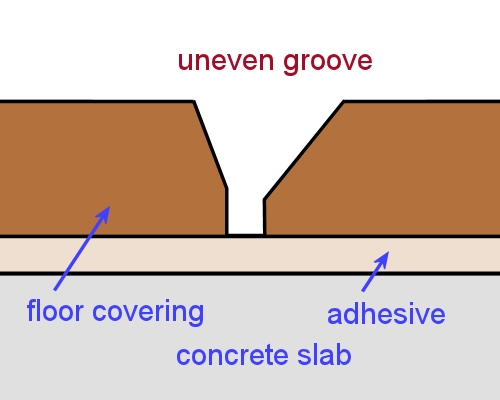 Audio for slide 97 (mp3)
Audio for slide 97 (mp3)
Groove Uneven groove If the edges of a seam aren't even, or the groove isn't centred properly, there won't be a consistent V-shaped depth to the groove. This will affect the strength of the weld.
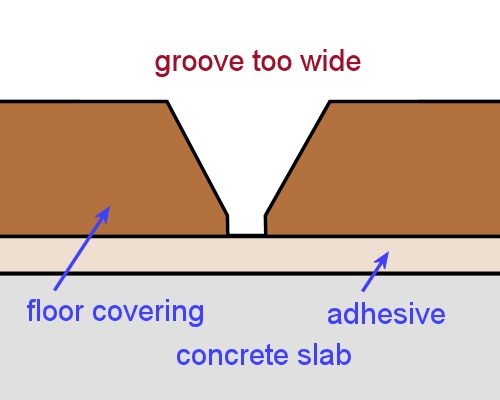 Audio for slide 98 (mp3)
Audio for slide 98 (mp3)
Groove too wide The width of the groove needs to be correct for the diameter of welding cable being used, otherwise the quantity of cable won't match the gap being filled.
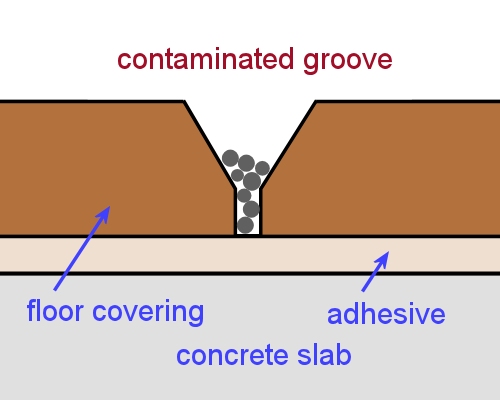 Audio for slide 99 (mp3)
Audio for slide 99 (mp3)
Contaminated groove If you allow dust or other contaminants to fall into the groove, the weld won't bond properly. Don't groove the whole area before you start welding - only groove the seam you are about to weld.
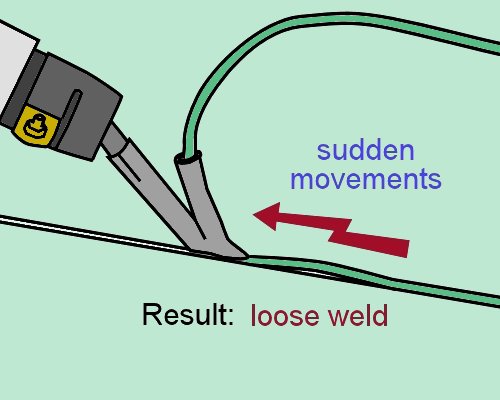 Audio for slide 100 (mp3)
Audio for slide 100 (mp3)
Welding gun Sudden movements If you reposition your body and make the weld tip jump while you're welding, it can result in a loose section of welded material.
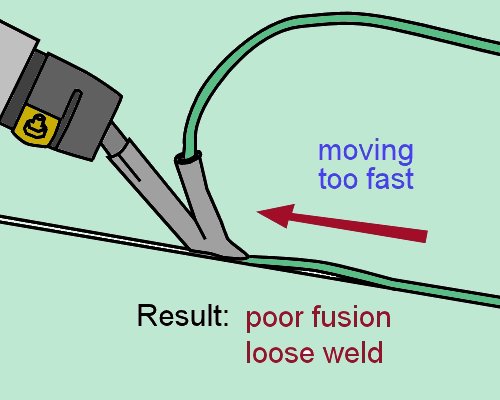 Audio for slide 101 (mp3)
Audio for slide 101 (mp3)
Moving too fast The gun needs to be pulled along the groove at just the right speed for the temperature setting and material being welded. If it's too fast there won't be enough time for the fusion to take place.
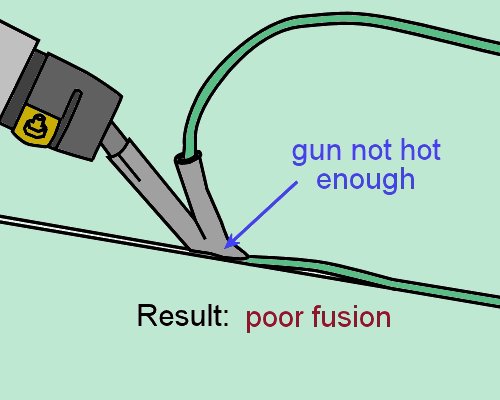 Audio for slide 102 (mp3)
Audio for slide 102 (mp3)
Gun not hot enough It takes time for the gun to warm up, so you must wait until it reaches its operating temperature. Low heat will result in poor fusion.
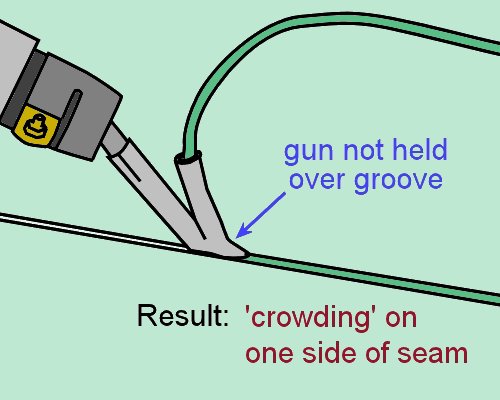 Audio for slide 103 (mp3)
Audio for slide 103 (mp3)
Gun not held over the groove If you hold the gun at an angle you'll 'crowd' one side of the seam. Make sure you keep the gun upright with an even pressure on the tip.
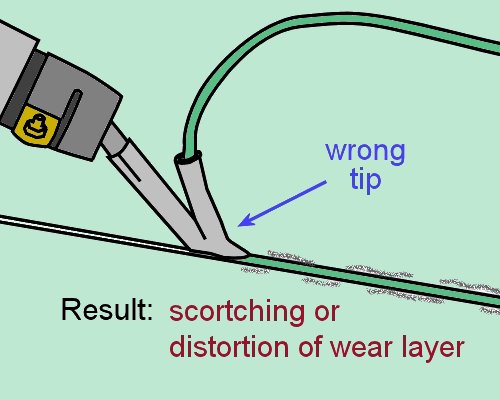 Audio for slide 104 (mp3)
Audio for slide 104 (mp3)
Wrong tip The tip must be the correct type and size for the cable and product being welded. If there is too much 'hot air wash' because the wrong tip is being used, you might scorch or distort the coating on the wear surface.
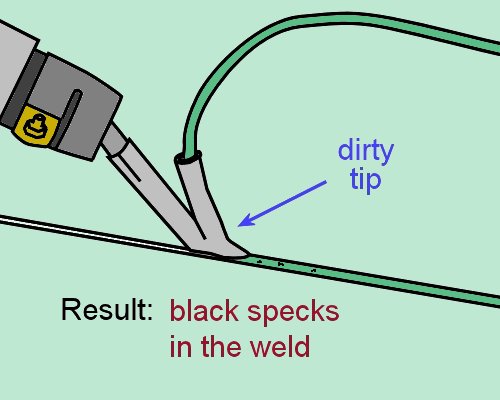 Audio for slide 105 (mp3)
Audio for slide 105 (mp3)
Dirty tip The tip must be cleaned after every weld, as residue can burn inside it and become embedded as black specks in the next weld.
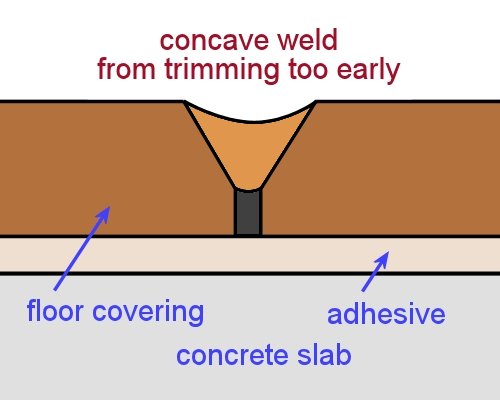 Audio for slide 106 (mp3)
Audio for slide 106 (mp3)
Trimming Trimming too early or too late The timing of the first trimming pass is determined by the material you're welding. With commercial vinyl you should do the first pass while the weld is still warm, and then let it cool completely before doing the second pass. If you're too quick with the second pass, you might end up with a severely concaved weld.
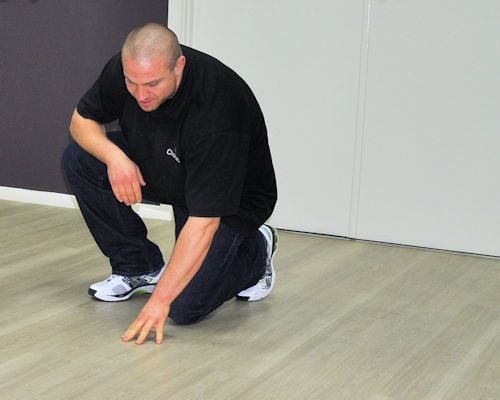 Audio for slide 108 (mp3)
Audio for slide 108 (mp3)
Once you've completed the installation you should carefully check the finished floor to make sure everything looks right. In particular, look for: loose edges or seams trapped air bubbles or buckles in the flooring adhesive on the surface.
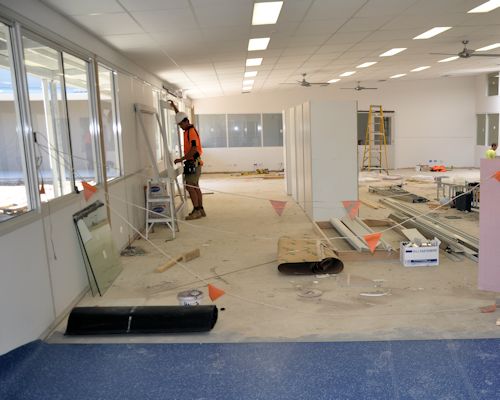 Audio for slide 109 (mp3)
Audio for slide 109 (mp3)
Protecting the new floor Depending on the type of worksite you're at, you might need to put up signs or barriers to stop people from entering the area until the adhesive has fully cured. In high traffic areas you can also put a protective covering over the floor to minimise the chance of damage. If you do, make sure the covering doesn't have a rubber or latex backing that might discolour the floor surface.
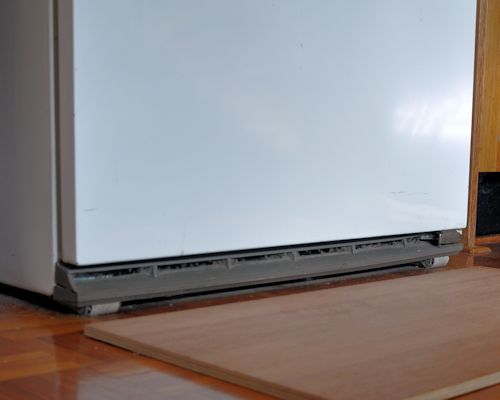 Audio for slide 110 (mp3)
Audio for slide 110 (mp3)
On projects where it's your job to move heavy appliances back into position, use plywood panels or other board products as protection underneath the appliance. Slide the first board under the object as you lift it off the floor one side at a time. Then put another board beside the first one and push the object over the boards. Don't roll or drag the object directly across the new flooring material. Commercial floors should be protected from rolling loads for at least 72 hours after the installation is finished.
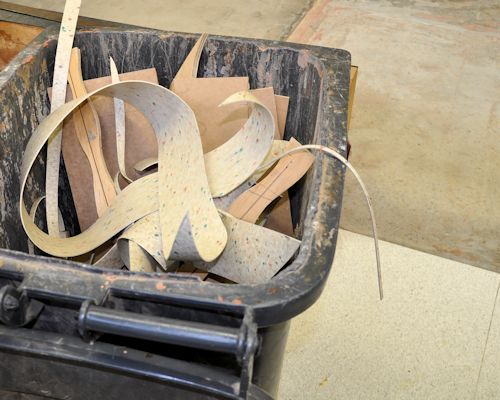 Audio for slide 111 (mp3)
Audio for slide 111 (mp3)
Housekeeping Take all your rubbish and materials with you, except for left-over pieces of floor covering that might be useful to the client for future repairs. Be particularly careful with hazardous products that need to be disposed of in an approved way. Don't put materials or rubbish in doorways or other access ways, because they'll probably get knocked over and end up being a trip hazard. Keep everything well stacked and out of everyone's way.
 Audio for slide 112 (mp3)
Audio for slide 112 (mp3)
Maintenance It's important to give the floor a good clean once the job is completed. You need to make sure that there is no grit left behind that could scratch the floor and no marks or dirt that might look unsightly. Be careful not to over-wet the floor in its initial clean. Although most flooring adhesives have a good resistance to moisture once the adhesive has cured, it often takes a few days for that level of resistance to be achieved. This is especially the case when alkaline cleaning liquids are used.
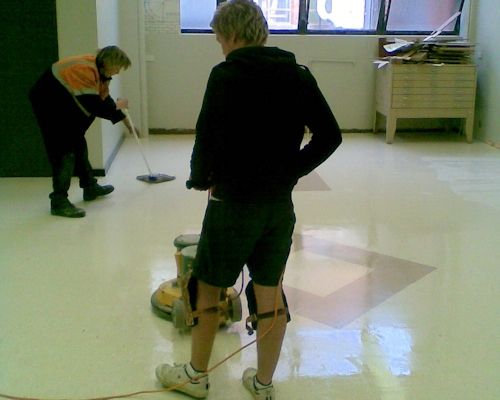 Audio for slide 113 (mp3)
Audio for slide 113 (mp3)
On small jobs you should mop up the dust and then use a low speed rotary machine to mechanically clean the floor. On large jobs it is often more cost effective to get a professional cleaner in to do the task with specialised equipment.
 Audio for slide 116 (mp3)
Audio for slide 116 (mp3)
The way you finish a floor covering at the borders will depend on the purpose of the floor and the design that the client has asked for. In this section, we'll examine the main types of coving used in commercial floors and methods used to install them.
 Audio for slide 117 (mp3)
Audio for slide 117 (mp3)
We'll also look at some basic techniques for incorporating motifs and features into a flooring project. These sorts of decorative designs can be as complex as the client's imagination and budget allow. However, the principles of cutting and fitting them remain much the same, even though in practice there may be a huge variation in the work involved in setting out and installing them.
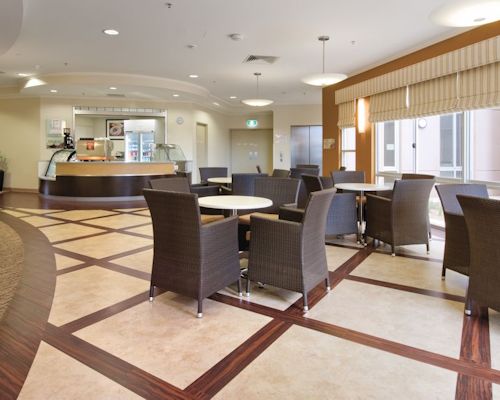 Audio for slide 119 (mp3)
Audio for slide 119 (mp3)
Borders and feature strips are designed to make a floor look more attractive. Borders go around the field area of a floor and can vary in size and style. Feature strips are generally narrower, and often form part of the overall floor design. Apart from these differences, they are much the same in terms of installation techniques.
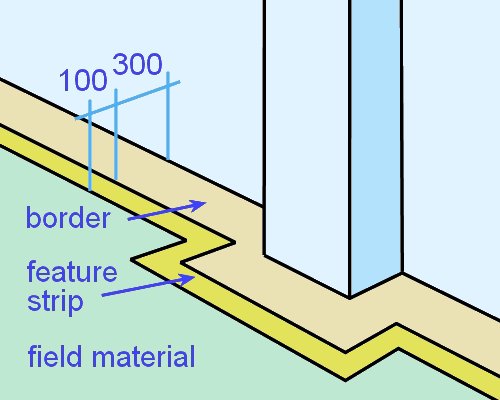 Audio for slide 120 (mp3)
Audio for slide 120 (mp3)
Installing a simple border This drawing shows a yellow feature strip set in 300 mm from the wall, and a beige coloured border against the wall. The steps involved in installing the border are as follows. Strike a chalk line to mark out the inside edge of the border pieces (that is, the edge furthest away from the wall). Cut the field material so it overlaps the chalk line by about 50 mm.
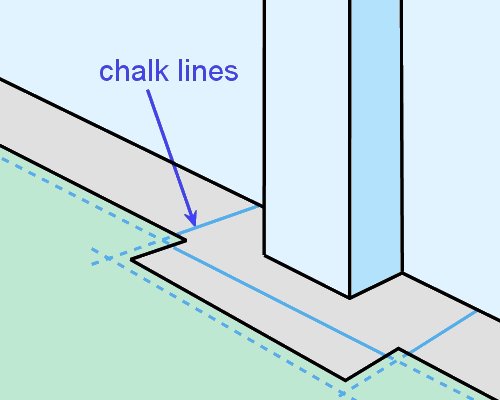 Audio for slide 121 (mp3)
Audio for slide 121 (mp3)
Spread the adhesive to the chalk line only and press in the field material, leaving the last 50 mm unstuck. Roll out the field material with a roller. Transfer the chalk line to the top of the field material, using the line on the floor either side of the material as reference marks.
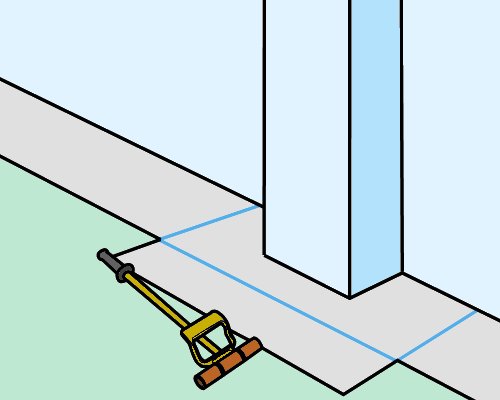 Audio for slide 122 (mp3)
Audio for slide 122 (mp3)
Cut along the line with a straight edge and upright knife and then roll the edges again. Cut the border strip 50 mm wider than its finished size will be (that is, cut it to 350 mm) to allow for scribing and trimming.
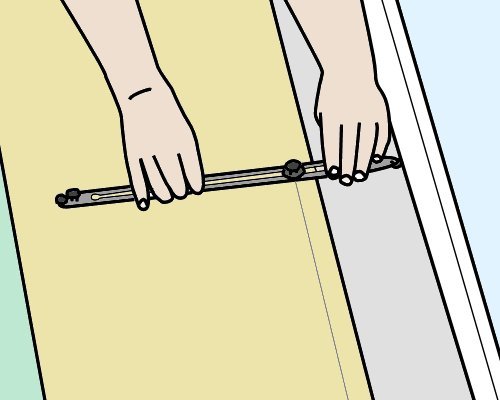 Audio for slide 123 (mp3)
Audio for slide 123 (mp3)
Butt the border piece against the field material, set the bar scriber to make allowance for the 100 mm distance from the wall, and scribe the wall line onto the piece. Then cut the piece to size. Cut the feature strip to the exact width (100 mm).
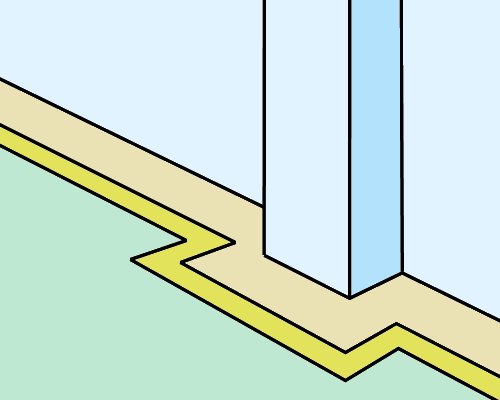 Audio for slide 124 (mp3)
Audio for slide 124 (mp3)
Check the fit of the feature strips and border pieces by putting them into position, starting at the inside and working towards the wall. Remove the pieces and spread adhesive between the wall and field. Press the pieces into position and roll thoroughly with a hand roller.
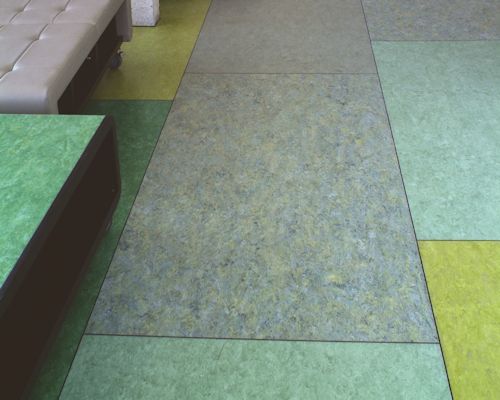 Audio for slide 125 (mp3)
Audio for slide 125 (mp3)
Some installers like to weld the seams using a contrasting colour of welding cable. A seam weld can even be used as a feature strip in its own right, set into the floor in a contrasting colour. It's also possible to install the border first, before you lay the field. This helps with the overlapping of the two colours in the weld.
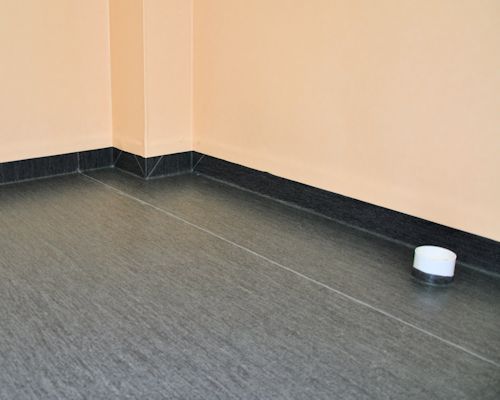 Audio for slide 127 (mp3)
Audio for slide 127 (mp3)
Coving is the process of turning up a sheet at the perimeter to provide a continuous surface between the floor and wall, or floor and other vertical surfaces. It's often used in commercial buildings, hospitals and schools, especially in areas where hygiene is important or a watertight seal is necessary.
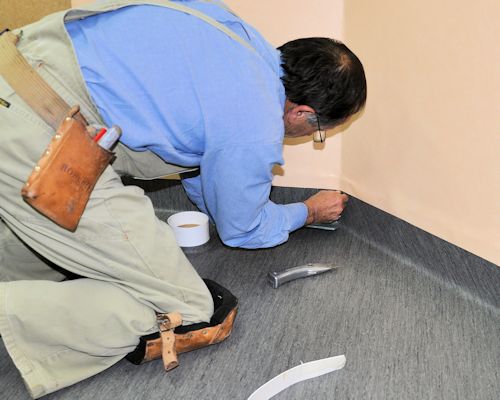 Audio for slide 128 (mp3)
Audio for slide 128 (mp3)
When the field material is used as the cove, the process is often called: flash coving, because the coving is 'flashed' up the wall, or integral coving, because the cove is an 'integral' part of the sheet.
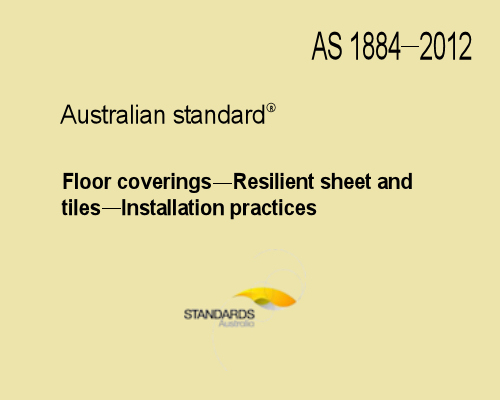 Audio for slide 129 (mp3)
Audio for slide 129 (mp3)
Types of coving Australian Standard 1884 describes three types of cove: preformed, border, and pencil cove.
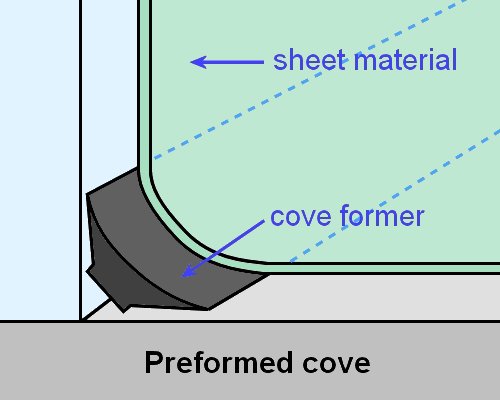 Audio for slide 130 (mp3)
Audio for slide 130 (mp3)
Preformed cove When a cove former or fillet is used to support the sheet at the floor and wall junction, the cove is called preformed, since the amount of curve is set by the fillet piece. We'll look in detail at the process used to install preformed coving in the next lesson.
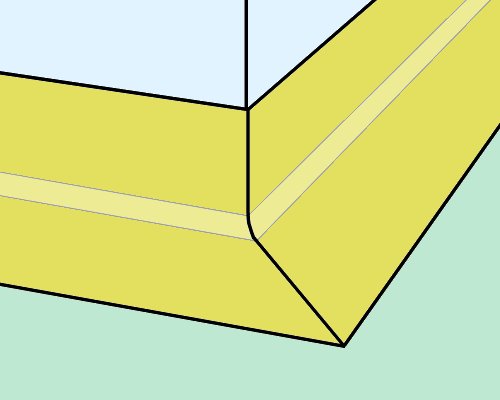 Audio for slide 131 (mp3)
Audio for slide 131 (mp3)
Border cove A border cove uses a separate piece of sheet material which is joined at the floor to the field material. The border piece can be the same colour as the field material or a contrasting feature colour. Linoleum coving is generally installed in this way. We'll cover the installation process for border coving in the unit: Linoleum.
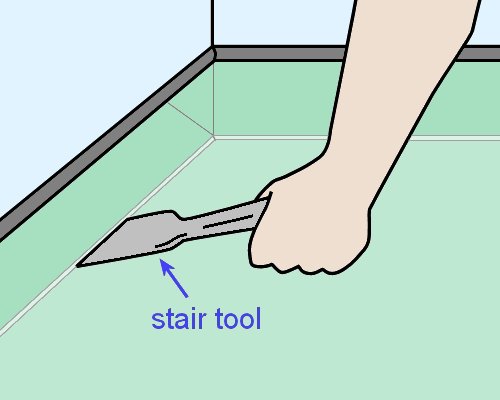 Audio for slide 132 (mp3)
Audio for slide 132 (mp3)
Pencil cove Vinyl sheets with good flexibility can be installed with a pencil cove. The field material is flashed up the wall, in the same way as with preformed coving, but there is no cove fillet involved. Instead, the material is simply pushed into the junction between the wall and floor with a stair tool. AS 1884 specifies that the radius of the curve for a pencil cove must be a maximum of 5 mm. To help achieve this tight radius, the material is warmed with a heat gun to make it more flexible.
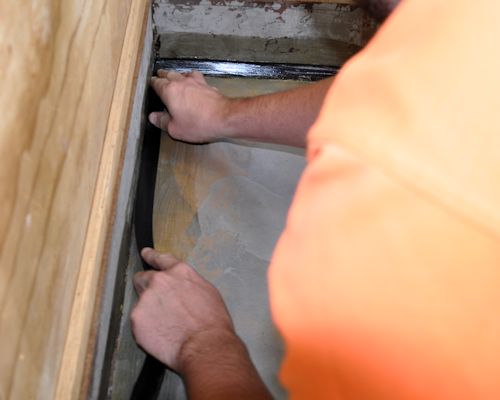 Audio for slide 134 (mp3)
Audio for slide 134 (mp3)
Cove former, or cove fillet, comes in a range of sizes - typically 20 mm, 32 mm and 38 mm. It is stuck in place with contact adhesive. Traditionally, a solvent-based adhesive was always used, but these days manufacturers often recommend two-part acrylic contact adhesives.
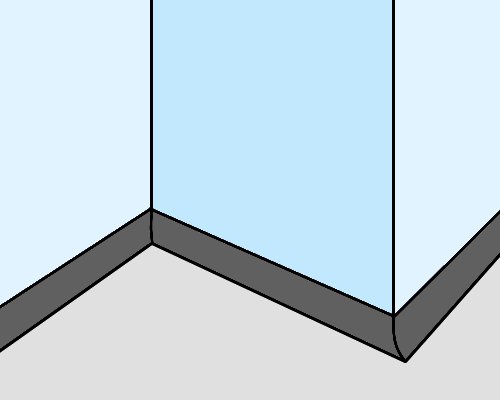 Audio for slide 135 (mp3)
Audio for slide 135 (mp3)
To fit a cove former into place: Apply contact adhesive to the back of the cove former and substrate with a brush or roller and allow it to 'tack up'. Carefully put the cove former in place and push it into the adhesive. Mitre the joints at corners with a utility knife.
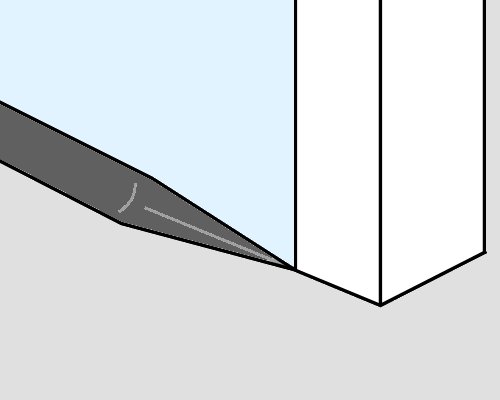 Audio for slide 136 (mp3)
Audio for slide 136 (mp3)
If the room has doorways without architraves (or has very thin architraves), you should taper the last 200 mm of cove former so that there is no gap at the end of the sheet. This is called fitting a 'reduced cove'.
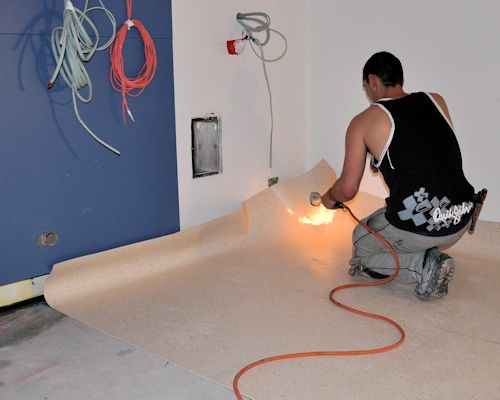 Audio for slide 138 (mp3)
Audio for slide 138 (mp3)
In many installations, the field material is flashed directly up the wall as a cove. When it's installed in a wet area, such as a shower or bathroom, the coving height must be at least 150 mm. Depending on the radius of the curve at the base, a heat gun may be used to make the floor covering more flexible, particularly at corners.
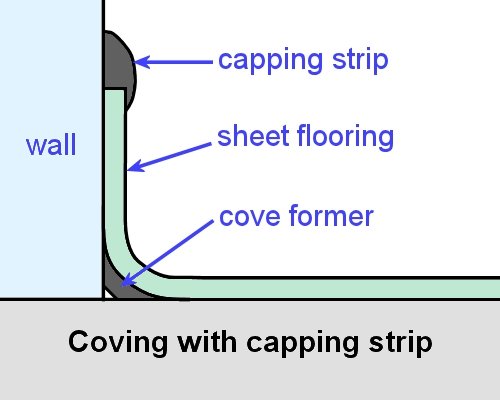 Audio for slide 139 (mp3)
Audio for slide 139 (mp3)
Some installations specify a cove former and capping strip. Others require a cove former only, with no capping.
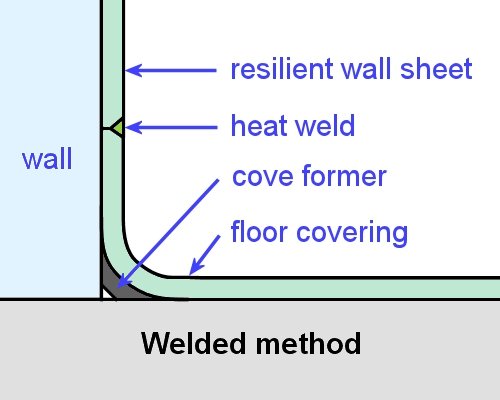 Audio for slide 140 (mp3)
Audio for slide 140 (mp3)
If you are joining a coved sheet to a resilient wall in a wet area, there are two possible ways of finishing the joint. Both methods are allowed in AS 1884. The first is the welded method, which is finished like a welded seam in the floor.
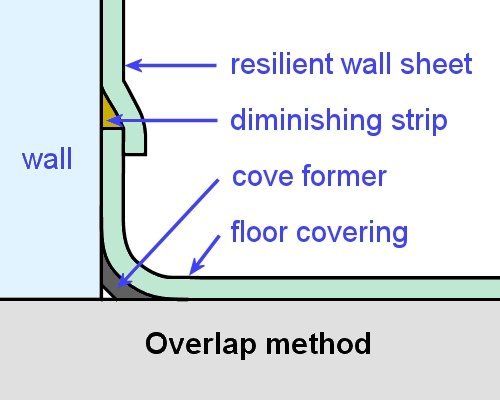 Audio for slide 141 (mp3)
Audio for slide 141 (mp3)
The second is the overlap method, which involves lapping the wall sheet over the coving and filling the space with a diminishing strip. This is the preferred technique in shower cubicles, because it provides more protection to the join.
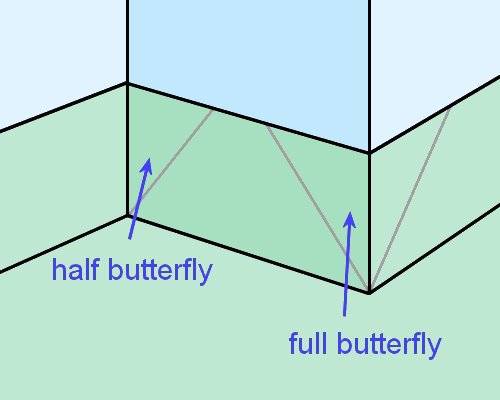 Audio for slide 142 (mp3)
Audio for slide 142 (mp3)
Internal and external 'butterfly' corners AS 1884 does not permit vertical welds in the corners of coved sheets in wet areas. This is because the weld could become a weak point if there is any movement in the substrate, which would reduce the corner's water resistance. Instead, the joints must be cut at 45 degrees to the corner.
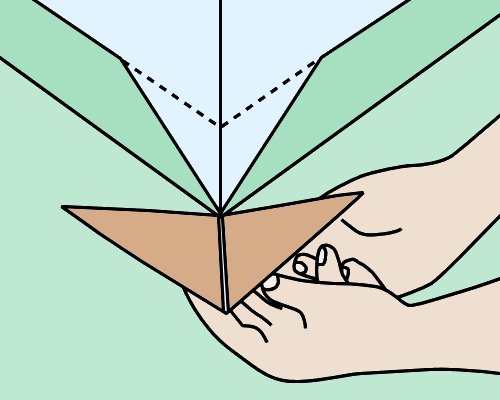 Audio for slide 143 (mp3)
Audio for slide 143 (mp3)
An easy way to do this with an external corner is to insert a V-shaped piece of material that wraps around the corner. This is called a full butterfly. The back of the butterfly piece is grooved to make it fold around the corner more easily.
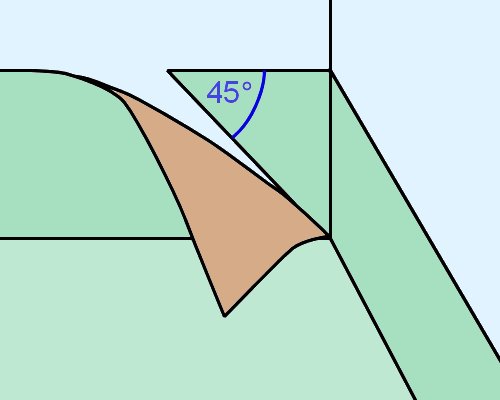 Audio for slide 144 (mp3)
Audio for slide 144 (mp3)
Internal corners are also finished at 45 degrees. In this case, the triangular piece that wraps around the corner is called a half butterfly. The link below goes to a video clip produced by Altro Flooring that demonstrates how to form butterfly corners. Note that it is called 'Alternative methods', because there are other clips in the Altro series that show how to cut and weld mitred corners with vertical joins. However, these techniques are not approved in AS 1884 for wet areas. Altro Flooring - 'Alternative methods'
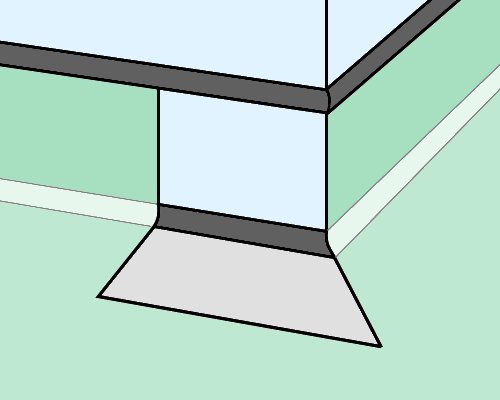 Audio for slide 145 (mp3)
Audio for slide 145 (mp3)
Mitred corners using a 'make-out' piece In areas where water resistance is not a priority, it's possible to mitre the corners with the aid of a separate make-out piece. However, the end result is a corner with a vertical join, so you must make sure that it will be acceptable in the project you're working on before you decide to finish the corner in this way. The video clip linked below shows the process for fitting internal and external mitres with a make-out piece. 'Altro handy hint - Fitting to an internal and external mitre':
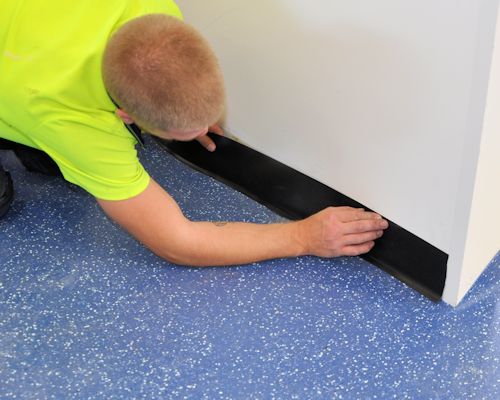 Audio for slide 147 (mp3)
Audio for slide 147 (mp3)
Cove skirting is an extruded vinyl product that's stuck to the wall around the floor perimeter. It's sometimes called: feather edge skirting, because it's tapered at the top and toe, or sit-on cove skirting, because it sits on top of the floor covering. The product is very flexible, so it can either be mitred at the corners, or simply wrapped around with the aid of relief cuts. It is often supplied in 15 metre coils.
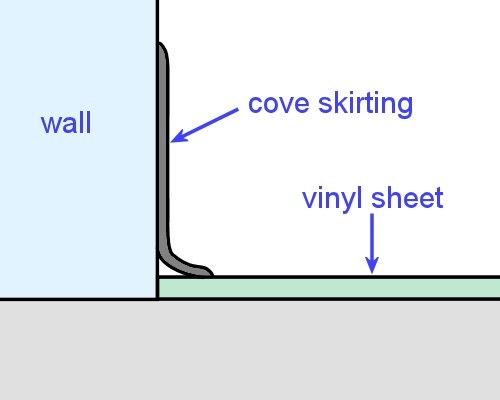 Audio for slide 148 (mp3)
Audio for slide 148 (mp3)
Straight lengths To fit straight lengths of cove skirting: Draw a pencil line on the wall to mark the height of the skirting. Spread contact adhesive on the wall to the pencil line and wait for it to tack up. Press the skirting into the adhesive, keeping the toe at an even distance from the wall.
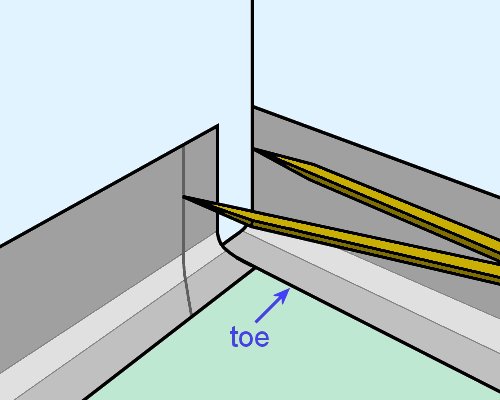 Audio for slide 149 (mp3)
Audio for slide 149 (mp3)
Internal corners To fit an internal mitred corner: Stick the first piece of skirting to one wall, leaving the toe un-mitred. Scribe the vertical part of the second piece with dividers and then mark the toe with a 45° internal mitre.
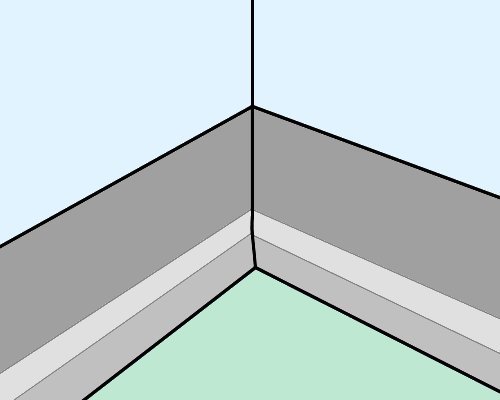 Audio for slide 150 (mp3)
Audio for slide 150 (mp3)
Cut the coving and chamfer the underside of the cut to ensure a tight fit. Stick the second piece to the toe of the first piece. To fit a wrap-around internal corner, roll the skirting around the corner and put a cut in the toe. Then push the skirting tightly into position, and double cut a 45 degree mitre into the toe.
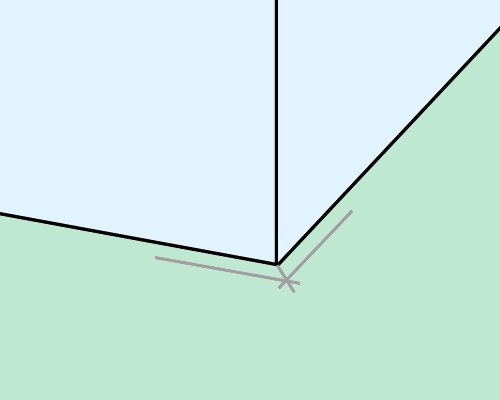 Audio for slide 151 (mp3)
Audio for slide 151 (mp3)
External corners To fit an external mitred corner: Place a piece of skirting along one wall, extending past the corner, and draw a pencil line on the floor against the toe. Then do the same on the other wall. Draw a line from the corner to the intersection of the two lines to mark the angle of the mitre.
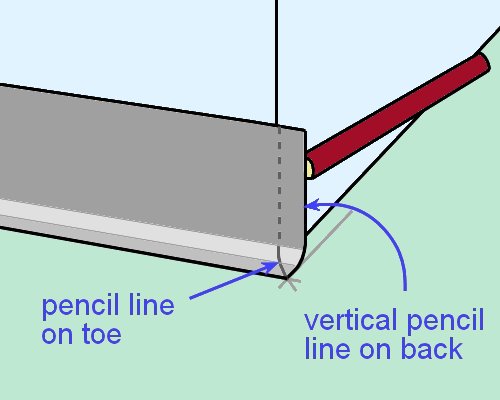 Audio for slide 152 (mp3)
Audio for slide 152 (mp3)
Place the first piece of coving in position and draw the mitre cut on top of the toe with a pencil. Then draw a vertical line down the back of the coving at the wall corner - using a small scrap as a spacer. Push a knife into the back of the coving at two points on the line - this will show as two white marks on the front of the coving, which can be used as guide marks - and then draw a corresponding line on the front.
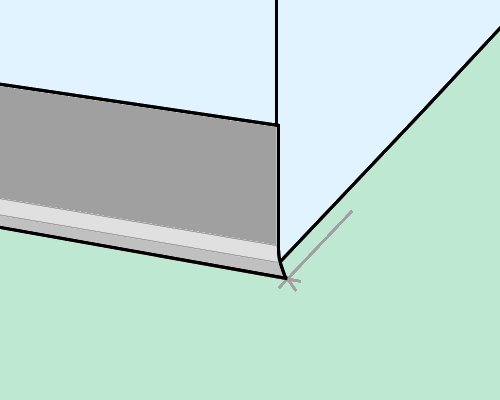 Audio for slide 153 (mp3)
Audio for slide 153 (mp3)
Cut the coving along the pencil line on the front, including the mitre at the toe. Pare away the face of the cut at a 45° angle. Prepare the other end of the piece, as required, and then stick the piece into position with contact adhesive.
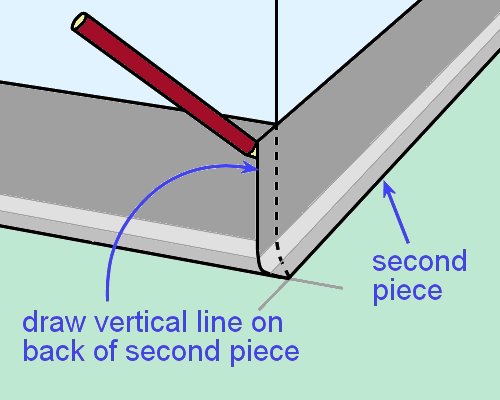 Audio for slide 154 (mp3)
Audio for slide 154 (mp3)
Put the second piece in position, overlapping the outside point of the mitre on the first piece. Mark that point on the toe of the second piece. Mark the vertical line on the back of the second piece by tracing along the line of the first piece.
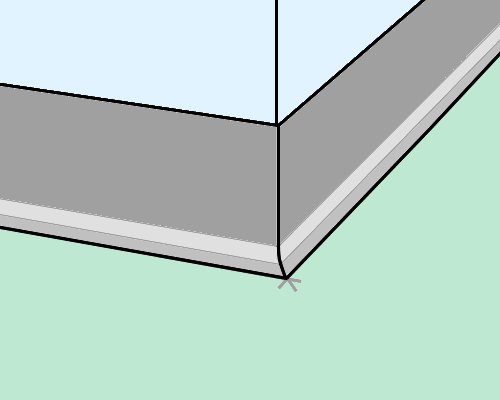 Audio for slide 155 (mp3)
Audio for slide 155 (mp3)
Cut and fit the second piece. To fit a wrap-around external corner, gently heat the skirting to improve its flexibility and wrap the skirting around the corner using a hand roller. If the external corner is tight, you may need to cut a groove in the back of the skirting to about ¼ of the depth, so it bends around the corner more easily.
 Audio for slide 157 (mp3)
Audio for slide 157 (mp3)
The processes used to insert motifs and make custom-designed patterns are similar in principle to those used for borders and feature strips. Most motifs these days are delivered to the site preassembled. They may already be inset into a surround that can be re-trimmed to size. Alternatively, they could be pre-cut to the precise finished shape.
 Audio for slide 158 (mp3)
Audio for slide 158 (mp3)
Installing pre-assembled motifs If the motif is inset in a surround that can be re-trimmed, you can use the following processes. Put the motif on the floor in position and mark the outline with a pencil. Then cut a hole in the sheet material, following the pencil line.
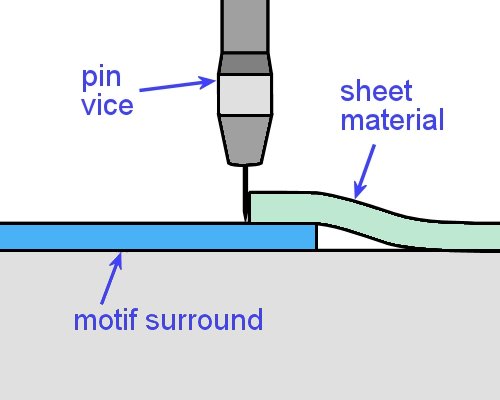 Audio for slide 159 (mp3)
Audio for slide 159 (mp3)
Slide the motif surround under the sheet material into its final position, under the hole, and trace the edge of the hole onto the surround using a pin vice. Remove the surround and cut it to its finished shape, holding the knife vertically.
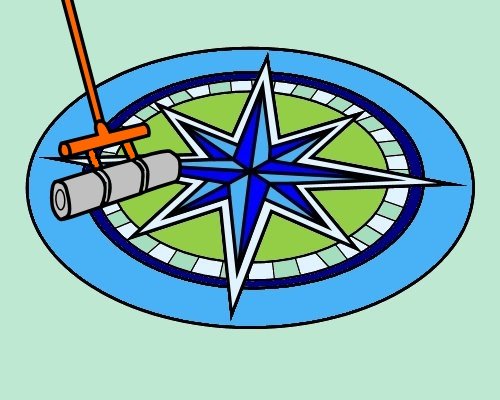 Audio for slide 160 (mp3)
Audio for slide 160 (mp3)
Check the fit, then spread adhesive over the area. Lay down the sheet material and motif and roll the area thoroughly.
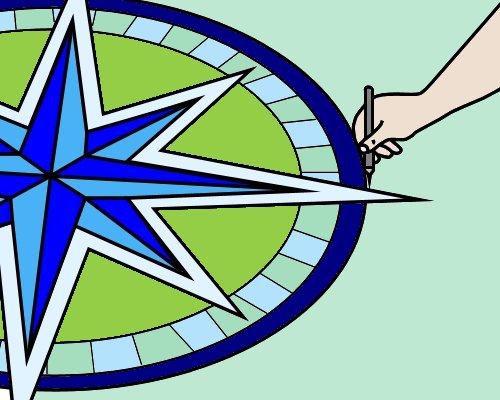 Audio for slide 161 (mp3)
Audio for slide 161 (mp3)
If the motif is already cut to its finished size, you should put it in position on the sheet material and hold it down firmly while tracing the outline with a pin vice. Then cut the sheet material to the exact shape.
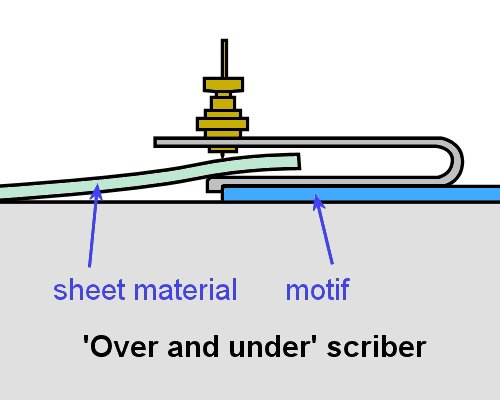 Audio for slide 162 (mp3)
Audio for slide 162 (mp3)
Alternatively, you can stick the finished motif directly to the subfloor first. Then place the sheet material over the top and rough cut a hole over the motif. Scribe the exact shape of the motif onto the sheet material with over and under scribers, and then cut the exact shape required.
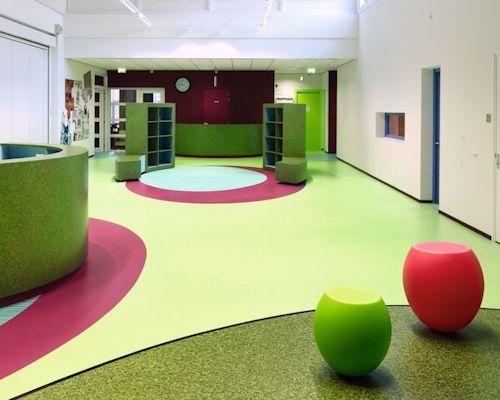 Audio for slide 163 (mp3)
Audio for slide 163 (mp3)
Site-cut patterns Large scale designs are generally assembled piece by piece on-site. In most cases this also means that a lot of the pieces need to be cut on-site, to make sure they'll fit tightly together.
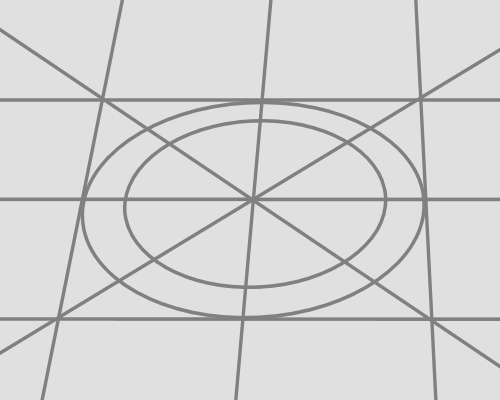 Audio for slide 164 (mp3)
Audio for slide 164 (mp3)
Here are some hints on installing site-cut patterned floors: Before you start, work out where any seams will go and make sure the client agrees with their positioning. Note that this may affect the material wastage, so it's best done at the quotation stage of the job. Agree with the client on the orientation of patterns and the direction of individual features. Mark out the design on the floor, including the centre points of circles or curves, to ensure that the assembly goes exactly to plan. Use a recess scriber to scribe adjoining pieces.

